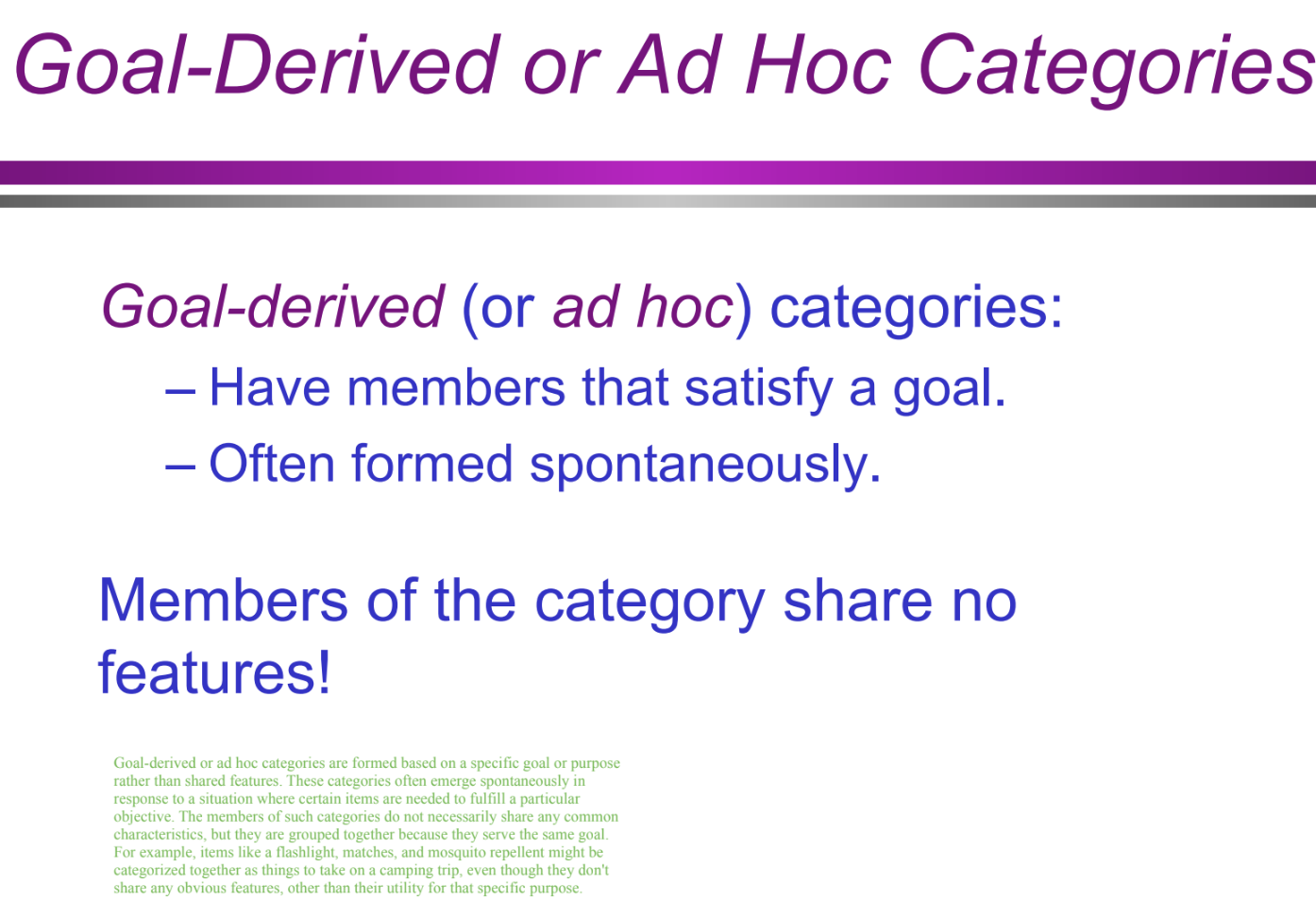Chapter 9: Conceptual Knowledge Pt 2 (Exemplar + Causal Model)
1/41
Earn XP
Description and Tags
By Jordana Burstein for Cognition
Name | Mastery | Learn | Test | Matching | Spaced |
|---|
No study sessions yet.
42 Terms
What is Exemplar Theory? (Categorization/Conceptual Structure: exemplar theory)
Exemplar Theory states that a category is represented by all previously encountered category members (exemplars), rather than a single prototype. Learning involves memorizing category members, and classification occurs by comparing a new object to stored exemplars and summing the total similarity to determine the best match.
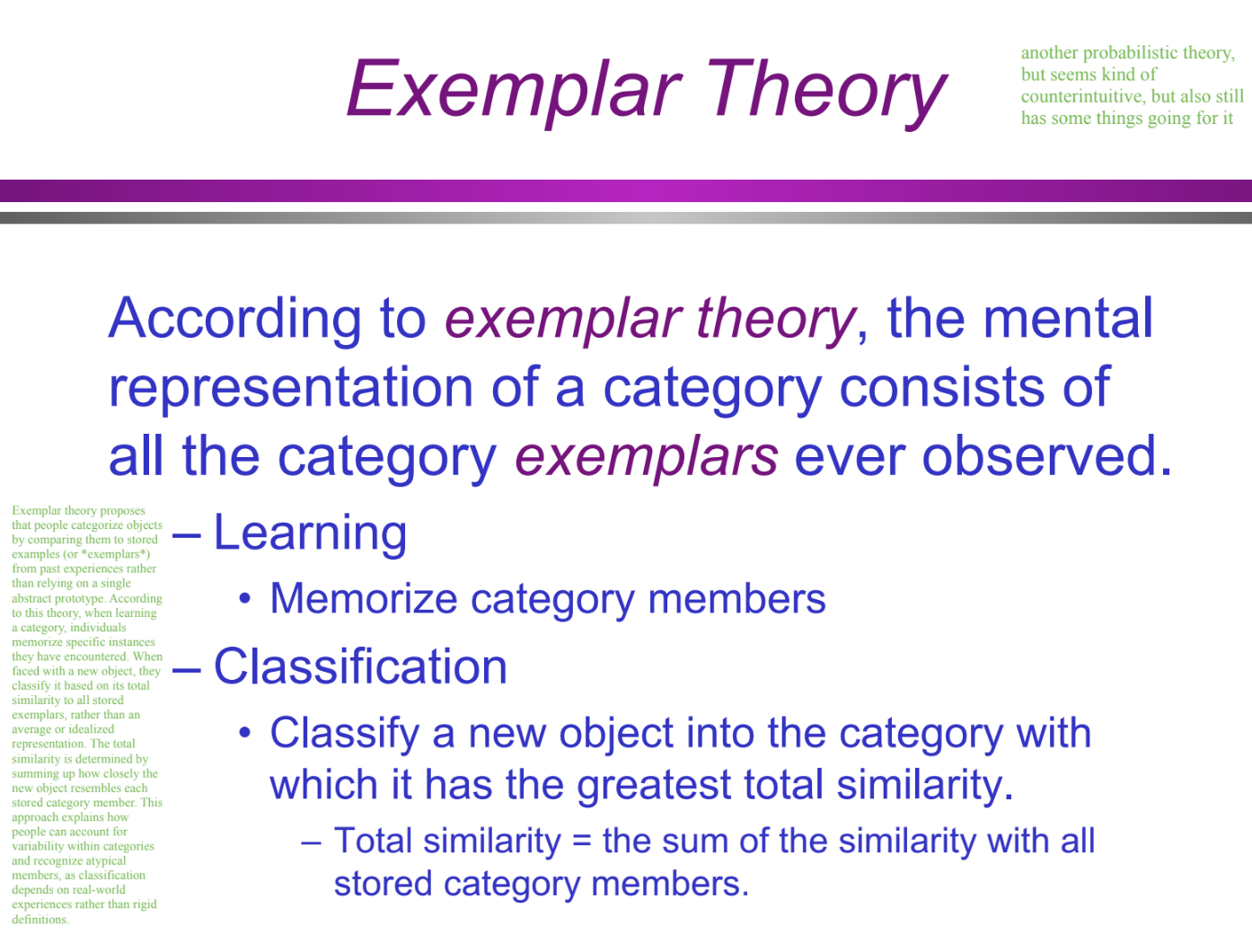
What is an exemplar in Exemplar Theory? (Categorization/Conceptual Structure: exemplar theory)
An exemplar is a specific, previously encountered instance of a category that is stored in memory and used for comparison when classifying new objects.
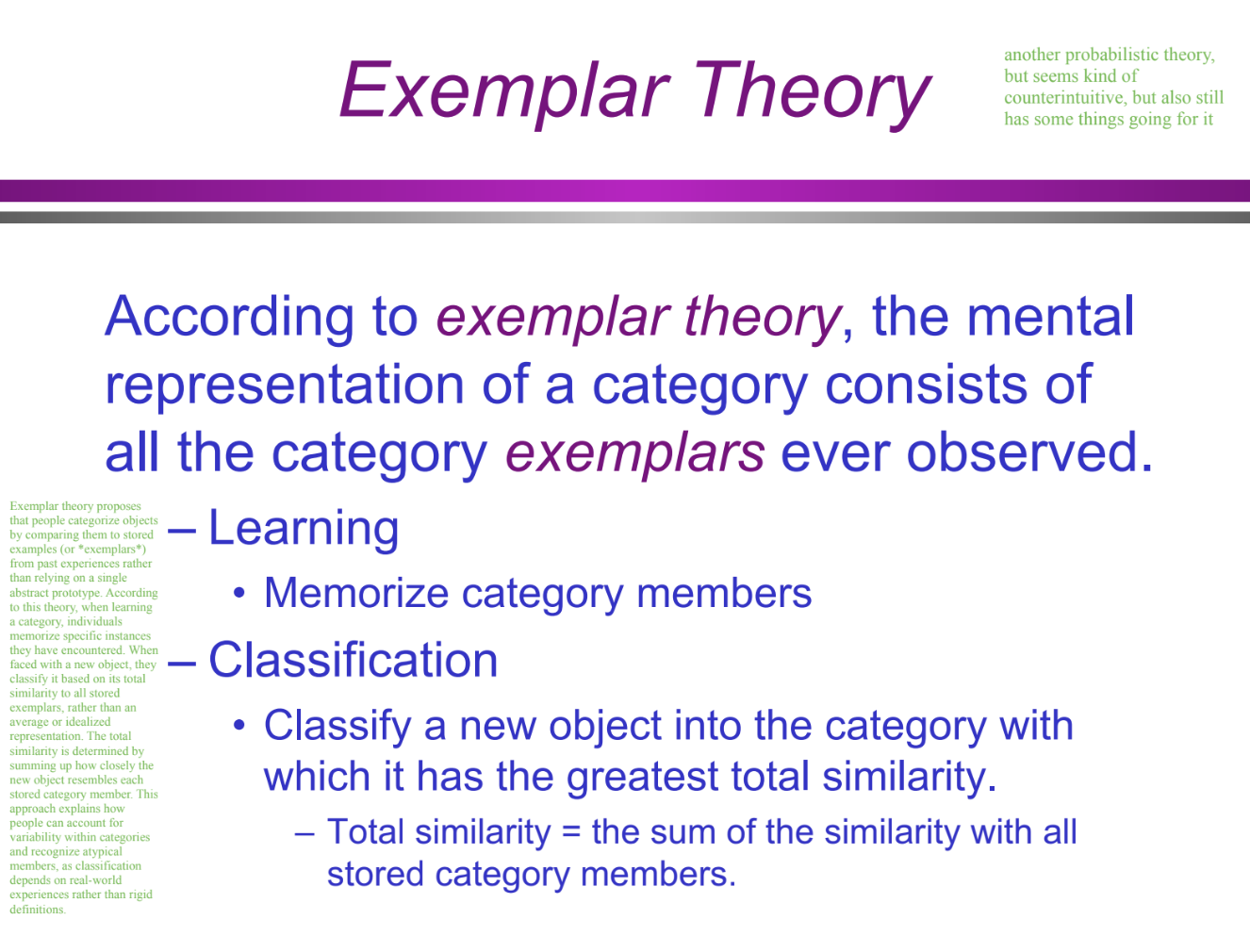
How does the Abbots vs. Bakers example illustrate Exemplar Theory? (Categorization/Conceptual Structure: exemplar theory)
A new face is classified by summing its similarity to all stored Abbot family members and comparing it to the total similarity with all Baker family members. If the total similarity is greater to the Abbots, the new face is categorized as an Abbot. This shows how categorization is based on past examples rather than a single prototype.
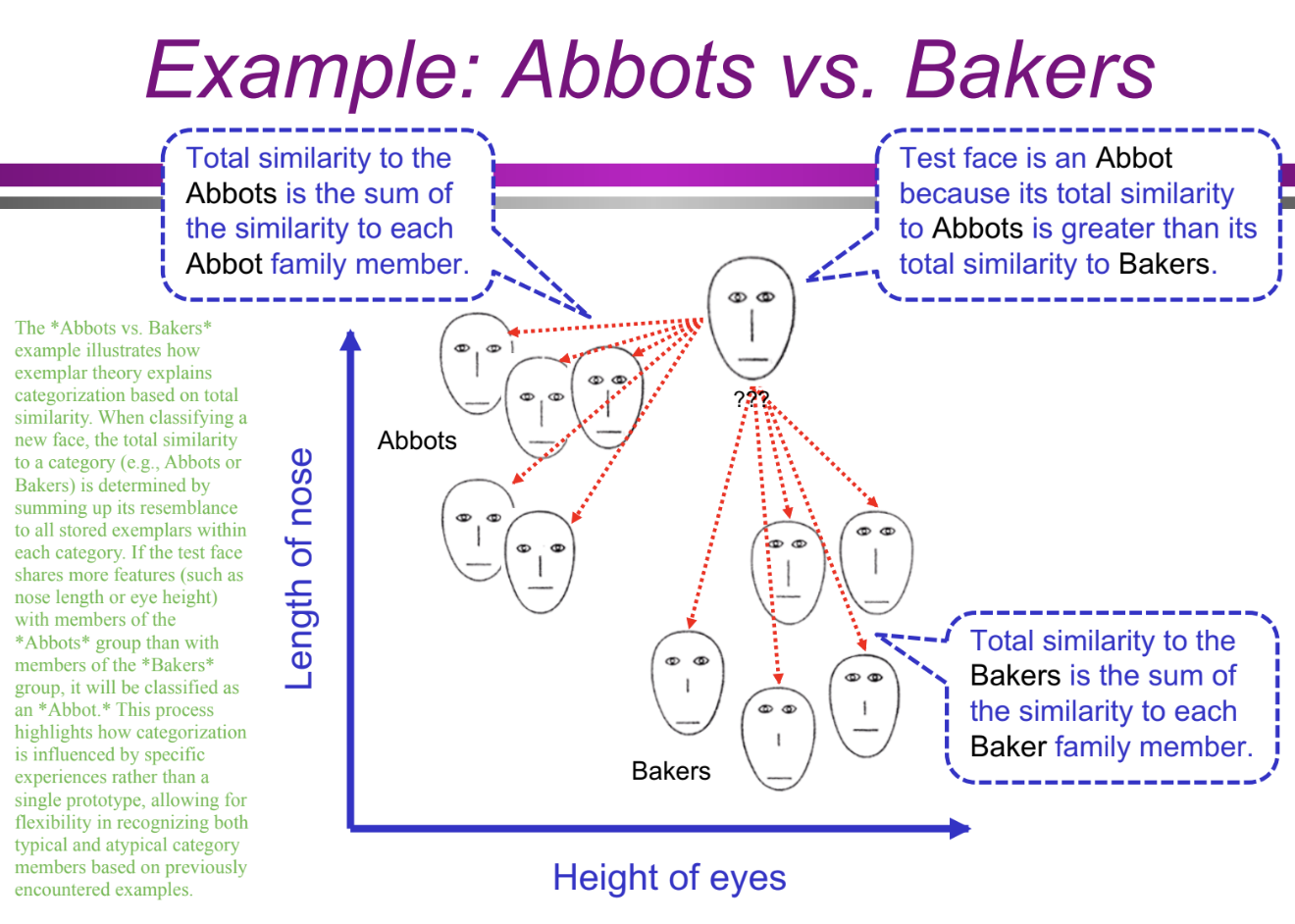
Does Exemplar Theory claim that we consciously recall each past category member? (Categorization/Conceptual Structure: exemplar theory)
No, consciously recalling every past category member would take too long. Instead, memory accesses all stored exemplars in parallel and determines which category the new object is most similar to.
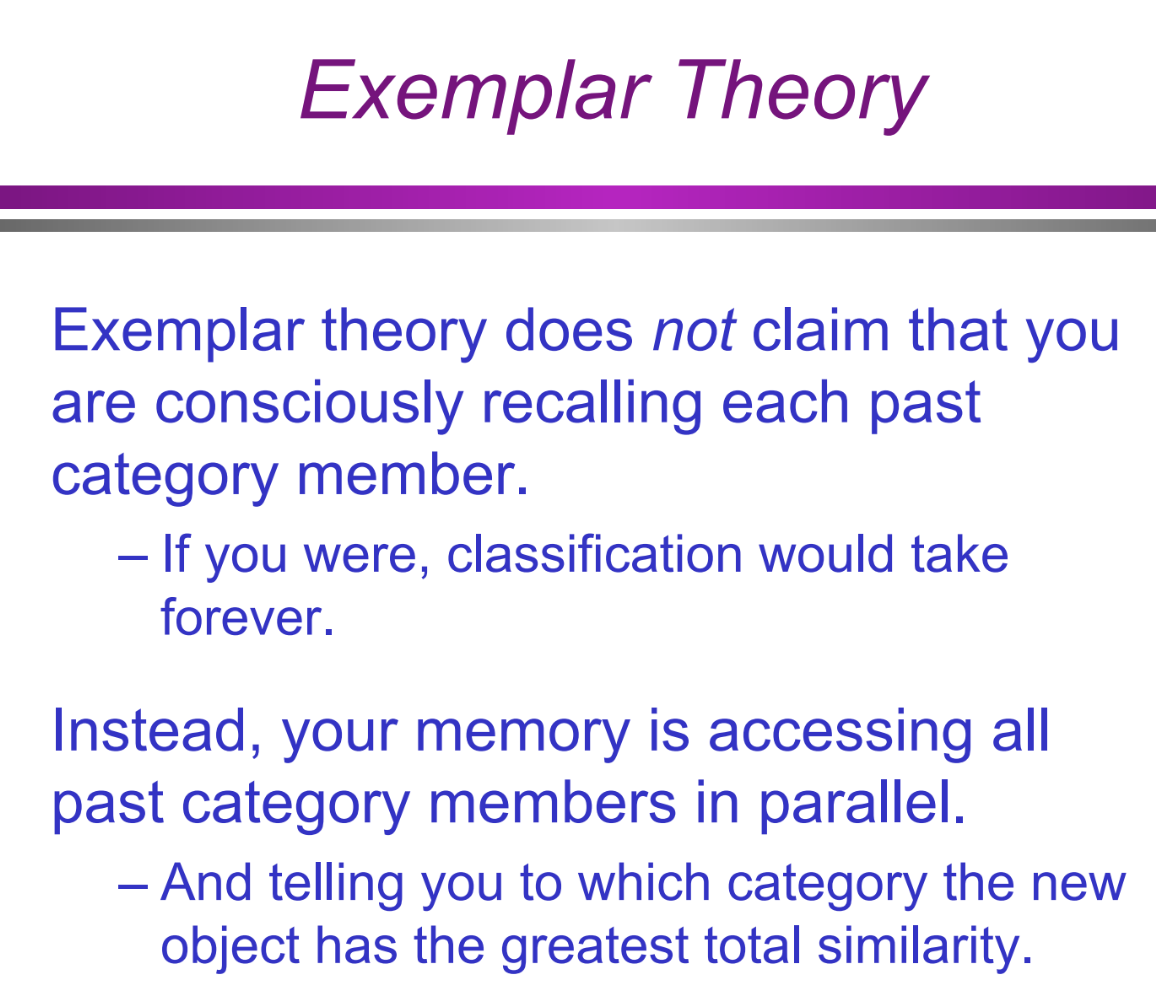
How does Exemplar Theory explain categorization in the Dog vs. Fish vs. Chair example? (Categorization/Conceptual Structure: exemplar theory)
A new object is classified by comparing it to stored exemplars of different categories. If an object shares the most total similarity with stored dog exemplars, it is classified as a dog rather than a fish or a chair.
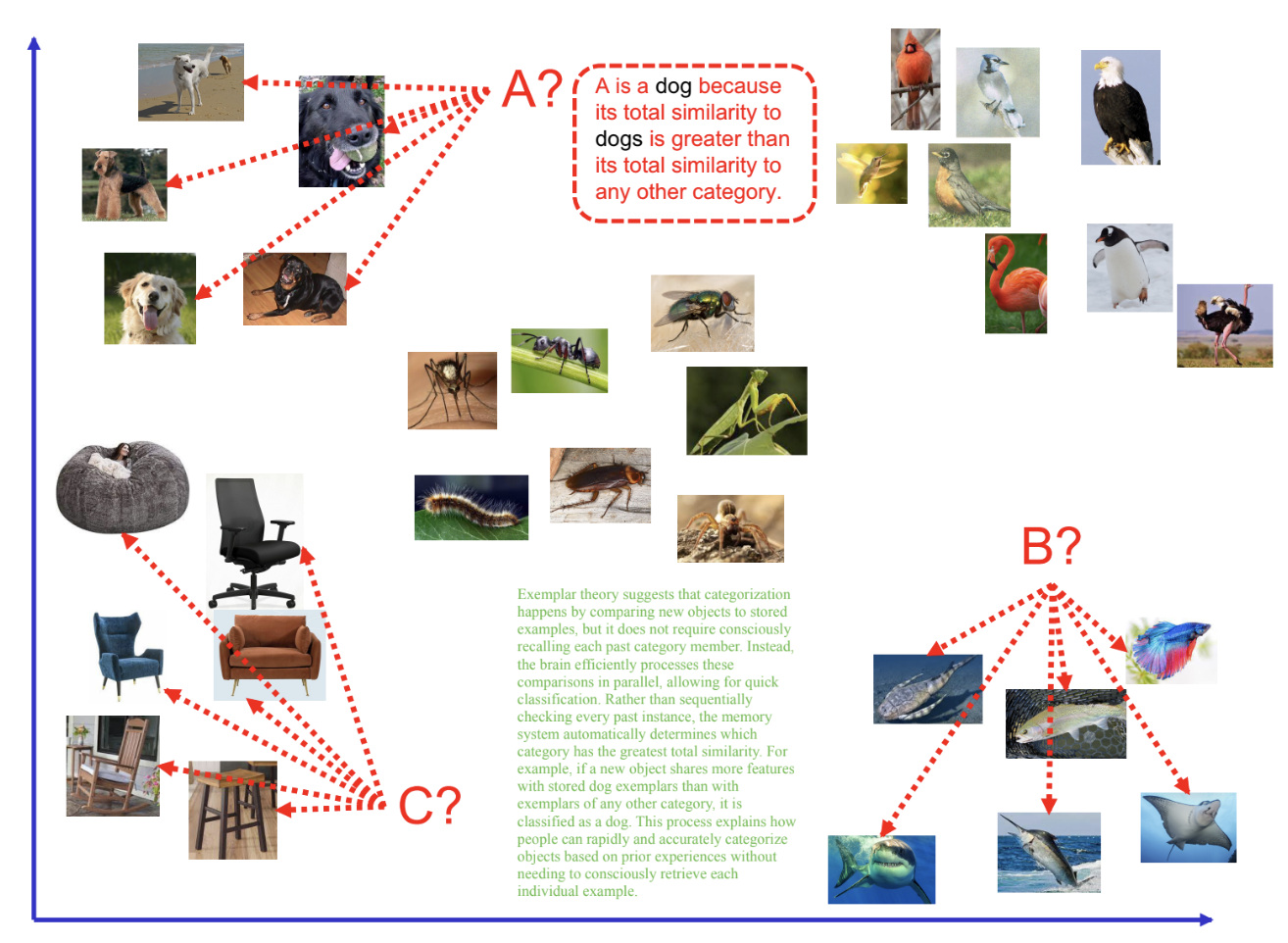
What are the advantages of Exemplar Theory? (Categorization/Conceptual Structure: exemplar theory)
Exemplar Theory explains key empirical categorization phenomena, including:
Typicality effects: More typical category members are closer in similarity to multiple stored exemplars, while atypical members are farther.
Borderline cases: Some objects have equal similarity to multiple categories, leading to classification uncertainty.
No defining features: Categorization is based on the sum of similarities rather than fixed rules.
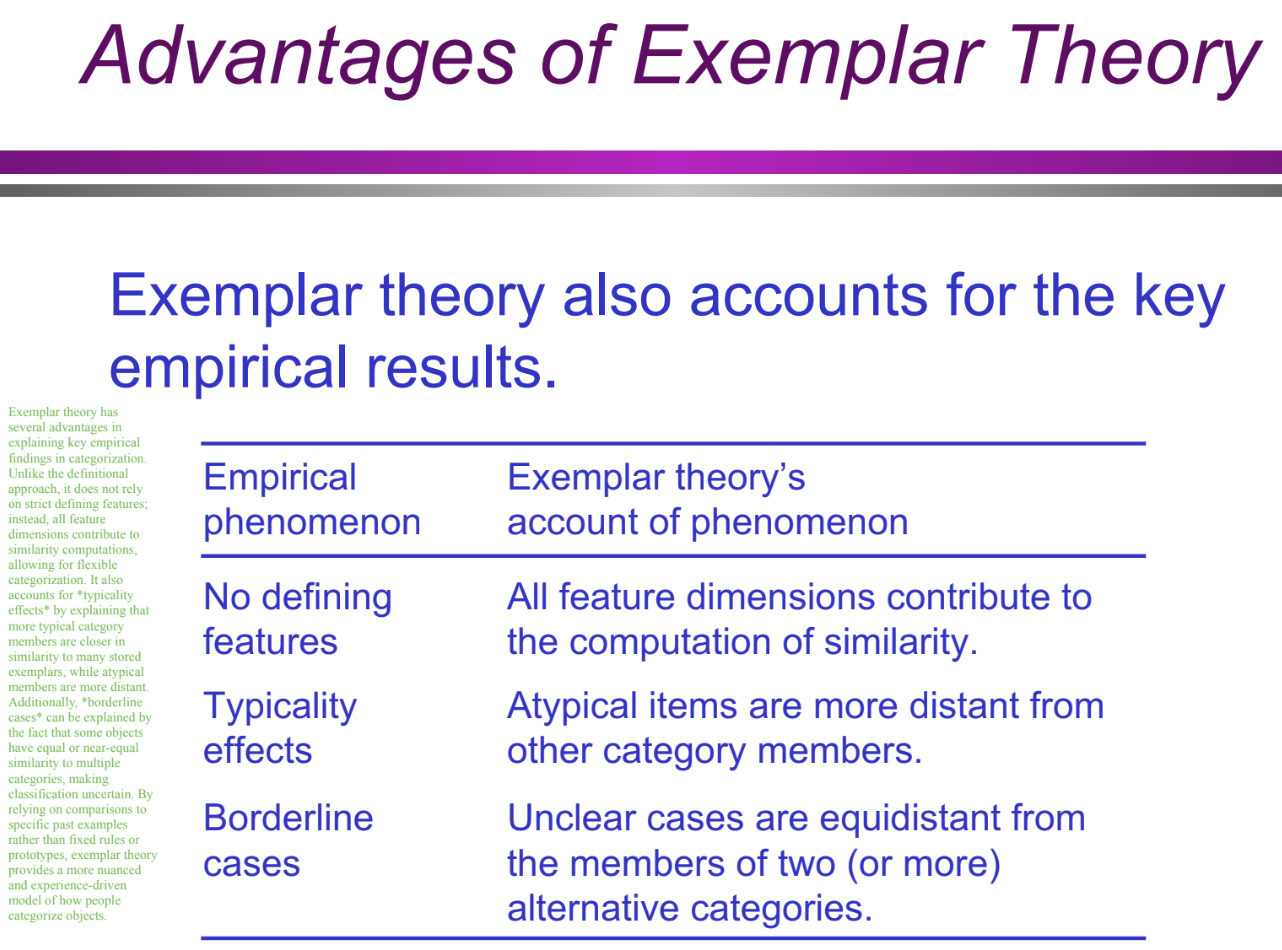
How does Exemplar Theory explain typicality effects and borderline cases? (Categorization/Conceptual Structure: exemplar theory)
Typicality effect: Typical category members (e.g., robins and sparrows) are highly similar to many stored exemplars, while atypical ones (e.g., penguins and ostriches) share fewer features with most category members.
Borderline cases: Objects with equal total similarity to multiple categories (e.g., an animal resembling both a cat and a penguin) lead to classification uncertainty.
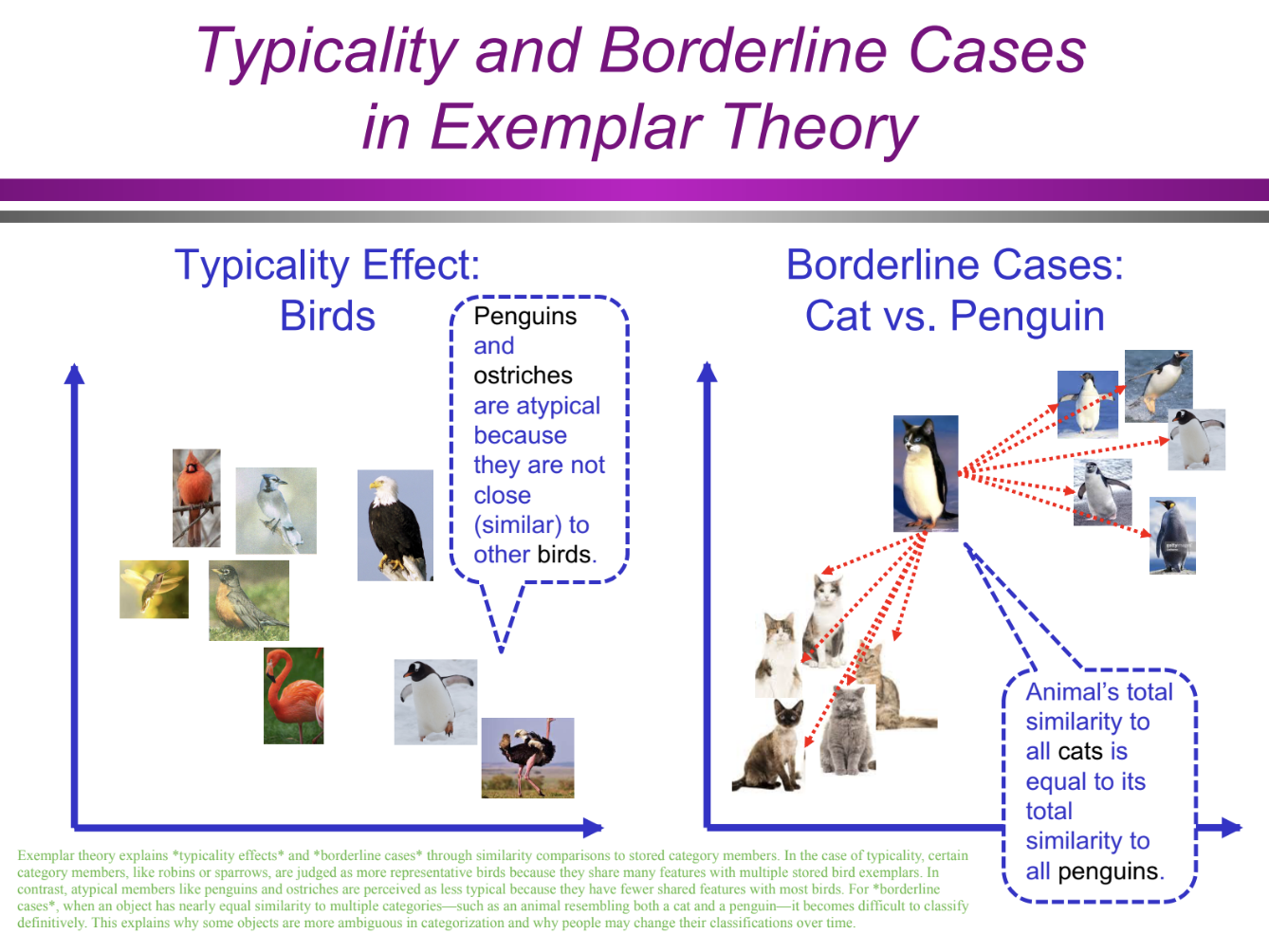
What are three key reasons Exemplar Theory is better than Prototype Theory? (Categorization/Conceptual Structure: exemplar theory)
Sensitivity to category variability – Exemplar Theory captures a wider range of category members, including atypical ones.
Sensitivity to feature correlations – It accounts for how different features interact, unlike Prototype Theory, which simplifies categories.
Sensitivity to exceptions – It stores specific examples, allowing it to recognize exceptions rather than relying on a single abstract prototype.
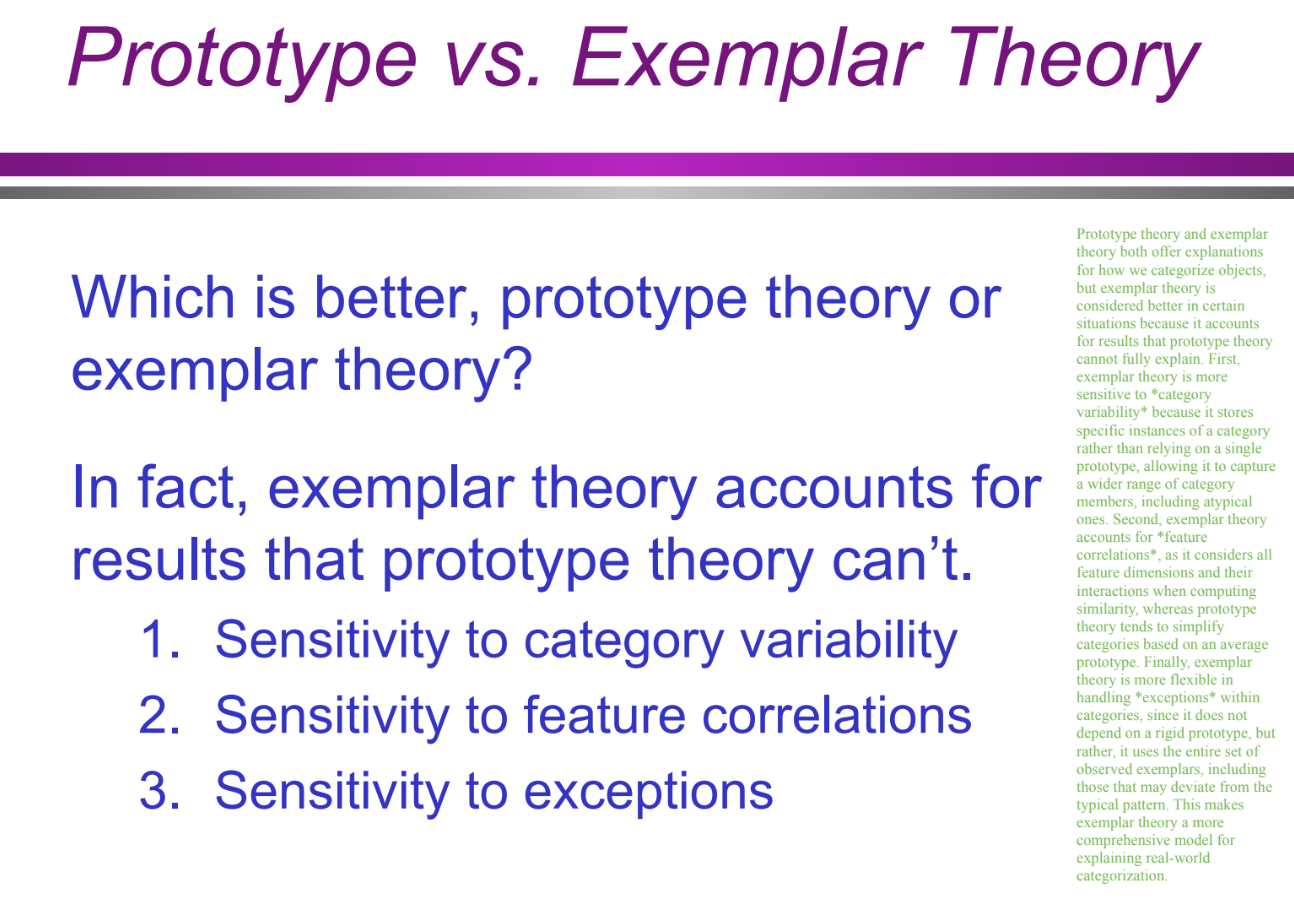
Why does Exemplar Theory handle category variability better than Prototype Theory? (Categorization/Conceptual Structure: exemplar theory: variability)
Prototype Theory loses information about category variability by averaging features into a single prototype. Exemplar Theory, however, retains multiple specific examples, allowing it to account for the diversity within a category (e.g., dogs being more variable than cats). Research shows people are sensitive to this variability (Fried & Holyoak, 1984; Flannagan et al., 1986).
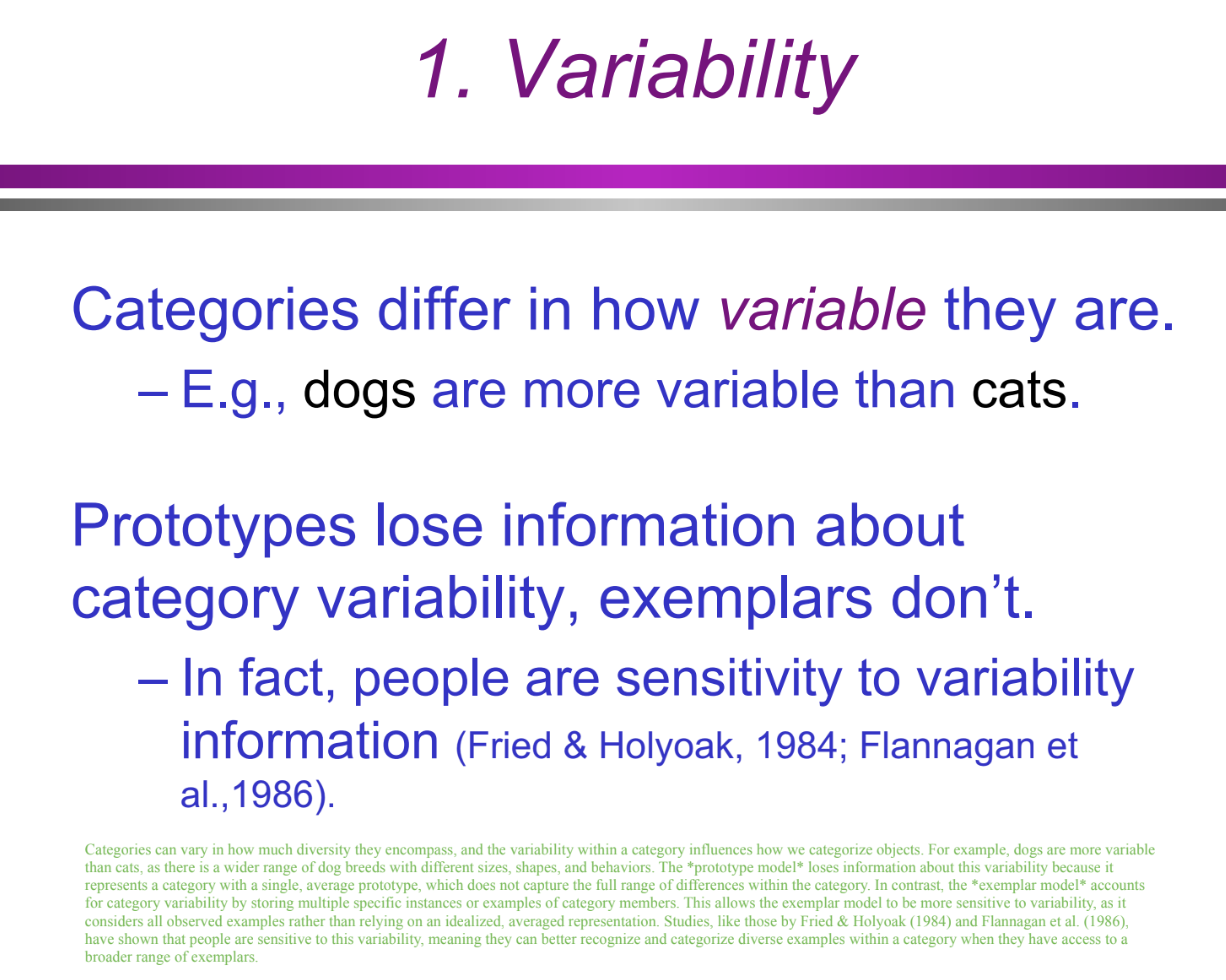
How does the Exemplar Model better explain category variability compared to the Prototype Model in the cats vs dogs example? (Categorization/Conceptual Structure: exemplar theory: variability)
Prototype Model: Averages features, losing information about the wide variability within categories (e.g., assuming all dogs are medium-sized and fluffy).
Exemplar Model: Stores multiple examples, recognizing that dogs vary more than cats in size, shape, and behavior. This allows for better categorization of diverse members within a category.
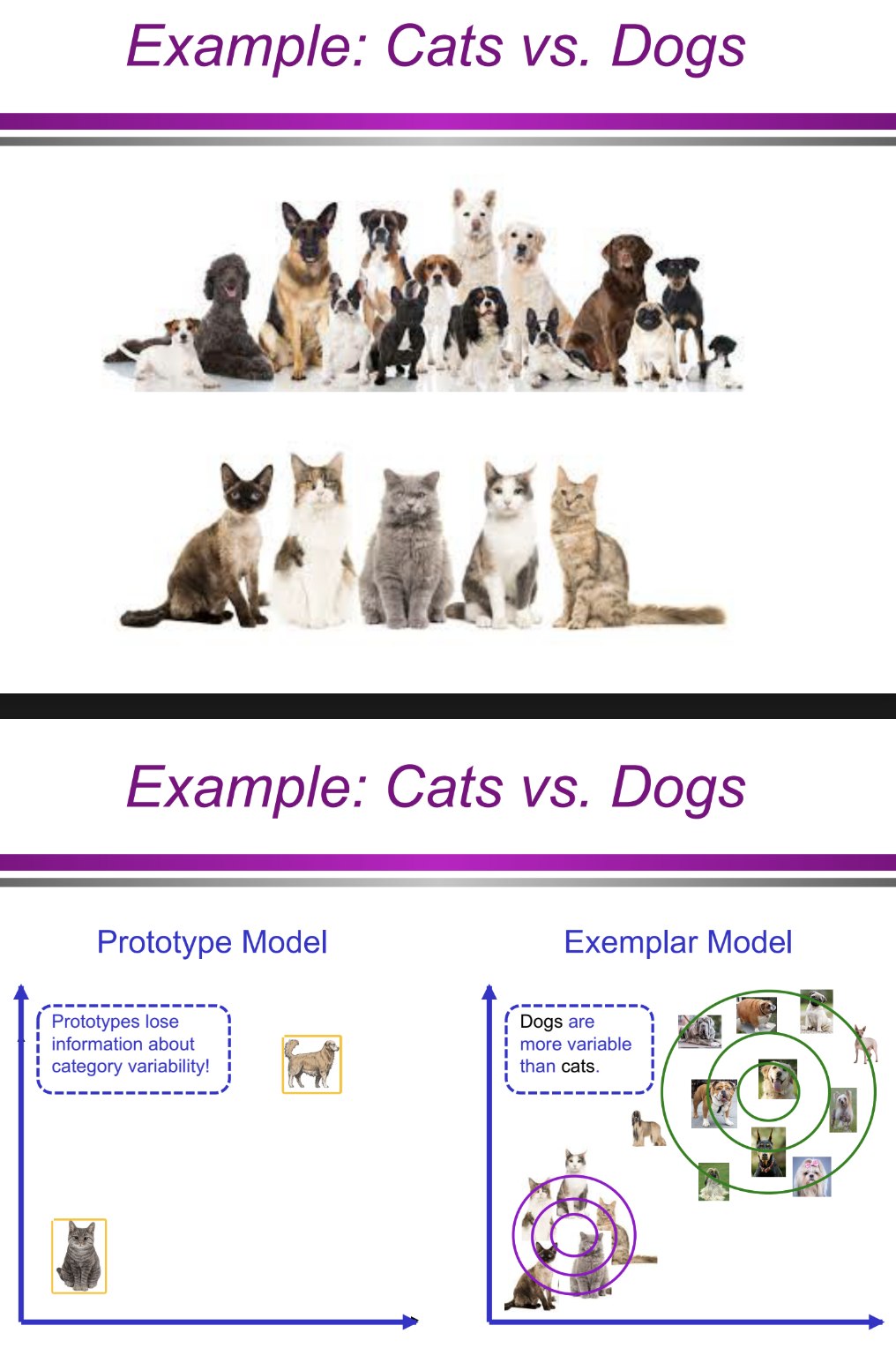
Why does Exemplar Theory handle feature correlations better than Prototype Theory? (Categorization/Conceptual Structure: exemplar theory: correlations)
Prototype Theory loses information about feature correlations by averaging features into a single prototype. Exemplar Theory, however, retains individual instances, preserving specific relationships between features (e.g., small birds sing, large birds don’t). Research (Anderson & Fincham, 1996; Ashby & Lee, 1990) shows that people are sensitive to these correlations, making Exemplar Theory more accurate in capturing real-world categorization.
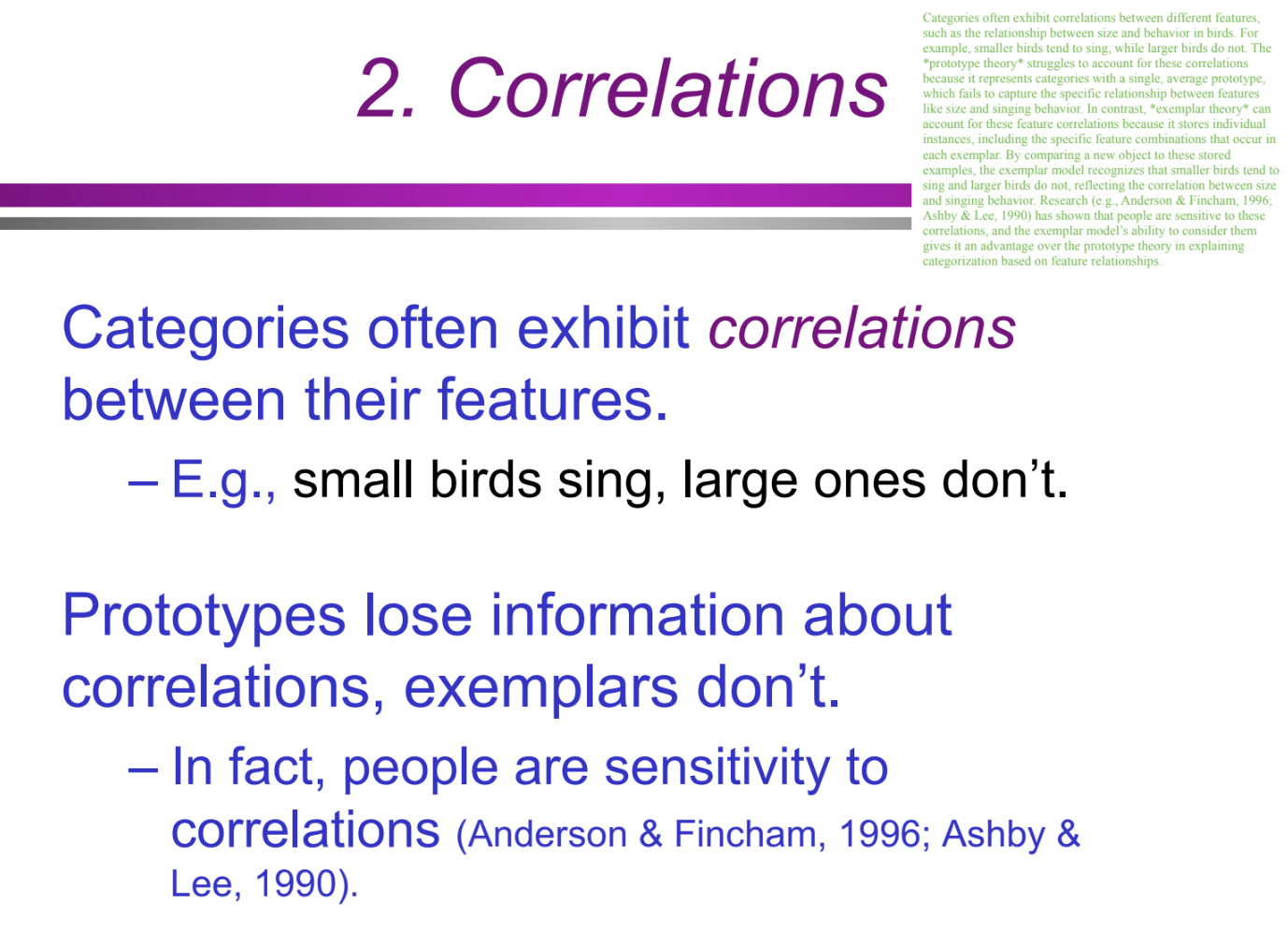
How does the Exemplar Model better represent correlations, as shown by the bird example? (Categorization/Conceptual Structure: exemplar theory: correlations)
Prototype Theory: Averages features, losing the correlation between size and singing ability, which means it cannot explain why small birds sing while large birds do not.
Exemplar Theory: Retains individual examples, preserving the correlation between weight and singing behavior. This allows correct categorization based on real-world patterns rather than an averaged prototype.
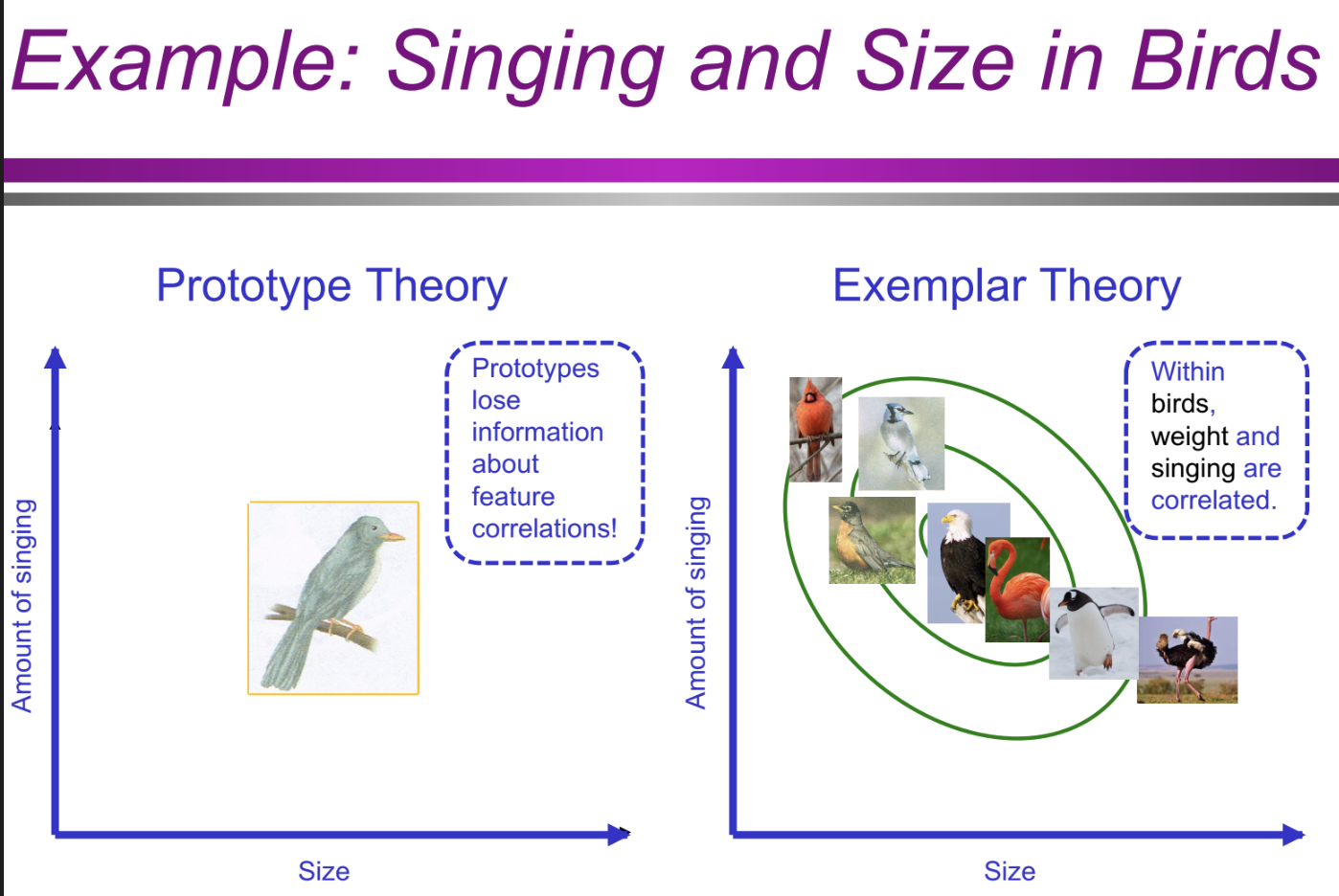
How does Exemplar Theory handle exceptions better than Prototype Theory? (Categorization/Conceptual Structure: exemplar theory: exceptions)
Some category members resemble another category’s prototype more than their own (e.g., whales and dolphins look like fish but are mammals). Prototype Theory misclassifies them due to reliance on an average prototype, while Exemplar Theory correctly categorizes them by comparing them to stored examples of whales and dolphins, preserving exceptions. Research (Medin & Schwanenflugel, 1981) supports that people can learn categories with exceptions, reinforcing Exemplar Theory’s advantage.
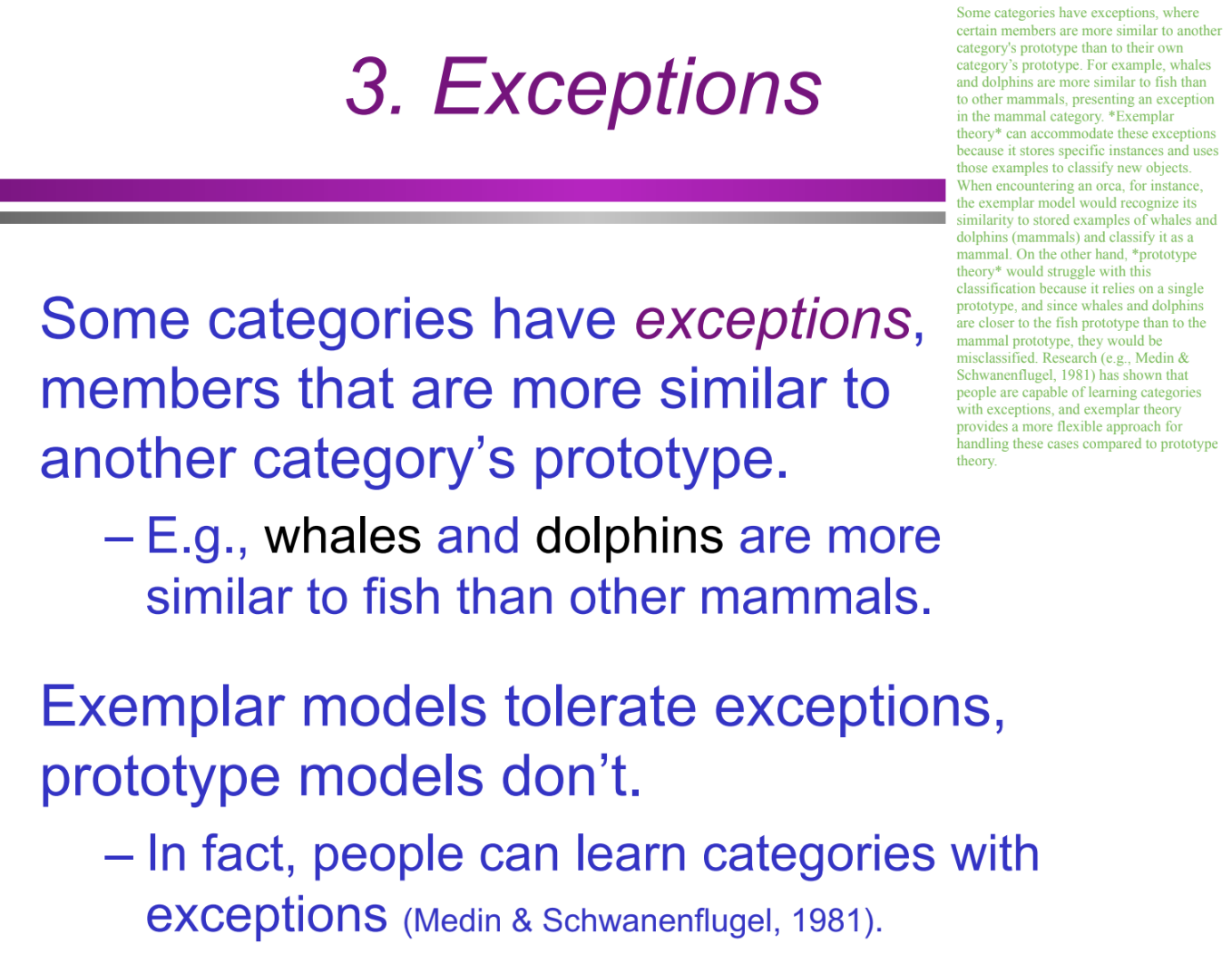
How do Exemplar and Prototype Theories differ in handling the fish vs. mammals exception? (Categorization/Conceptual Structure: exemplar theory: exceptions)
Prototype Theory: Misclassifies whales and dolphins as fish because they resemble a fish prototype more than a mammal prototype.
Exemplar Theory: Correctly classifies whales and dolphins as mammals by comparing them to stored mammal exemplars, recognizing their true category despite their similarity to fish.
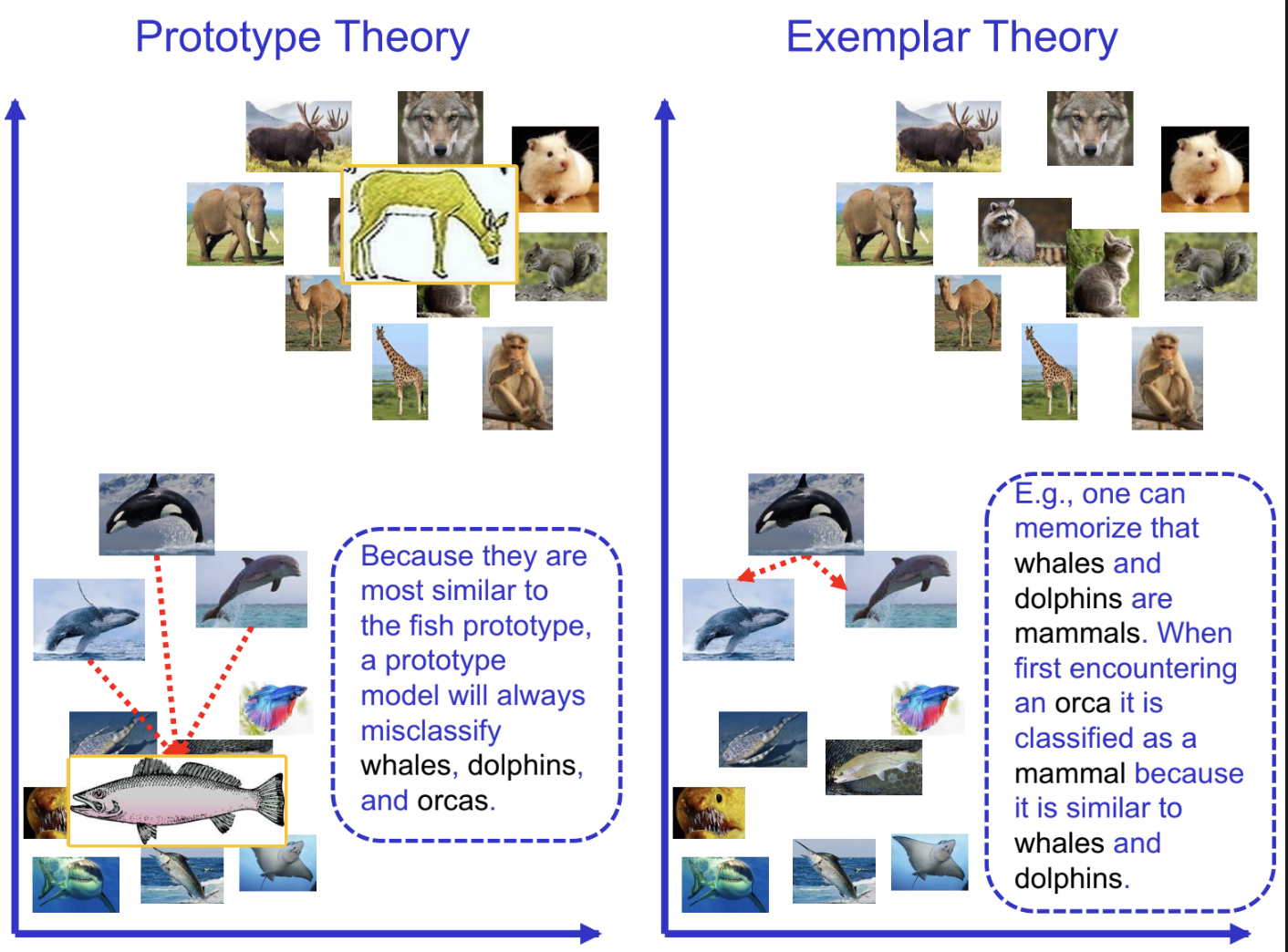
What are the key advantages of Exemplar Theory over Prototype Theory? (Categorization/Conceptual Structure: exemplar theory: exceptions)
Variability – Retains category diversity instead of averaging into a single prototype.
Feature Correlations – Preserves relationships between features (e.g., small birds sing, large birds don’t).
Exceptions – Handles atypical cases (e.g., whales and dolphins as mammals) by storing specific instances.
Since our brains track individual category members, Exemplar Theory offers a more flexible and accurate model of categorization.

What are hybrid theories in categorization? (Categorization/Conceptual Structure)
Hybrid theories propose that human categorization uses both prototypes and exemplars. People may first form a prototype as a general category representation and then refine it with exemplars from experience. Categories with fewer members tend to rely more on exemplars, while larger categories may use prototypes. Research (Keri et al., 2002; Malt, 1989) suggests this dual approach balances efficiency and accuracy.
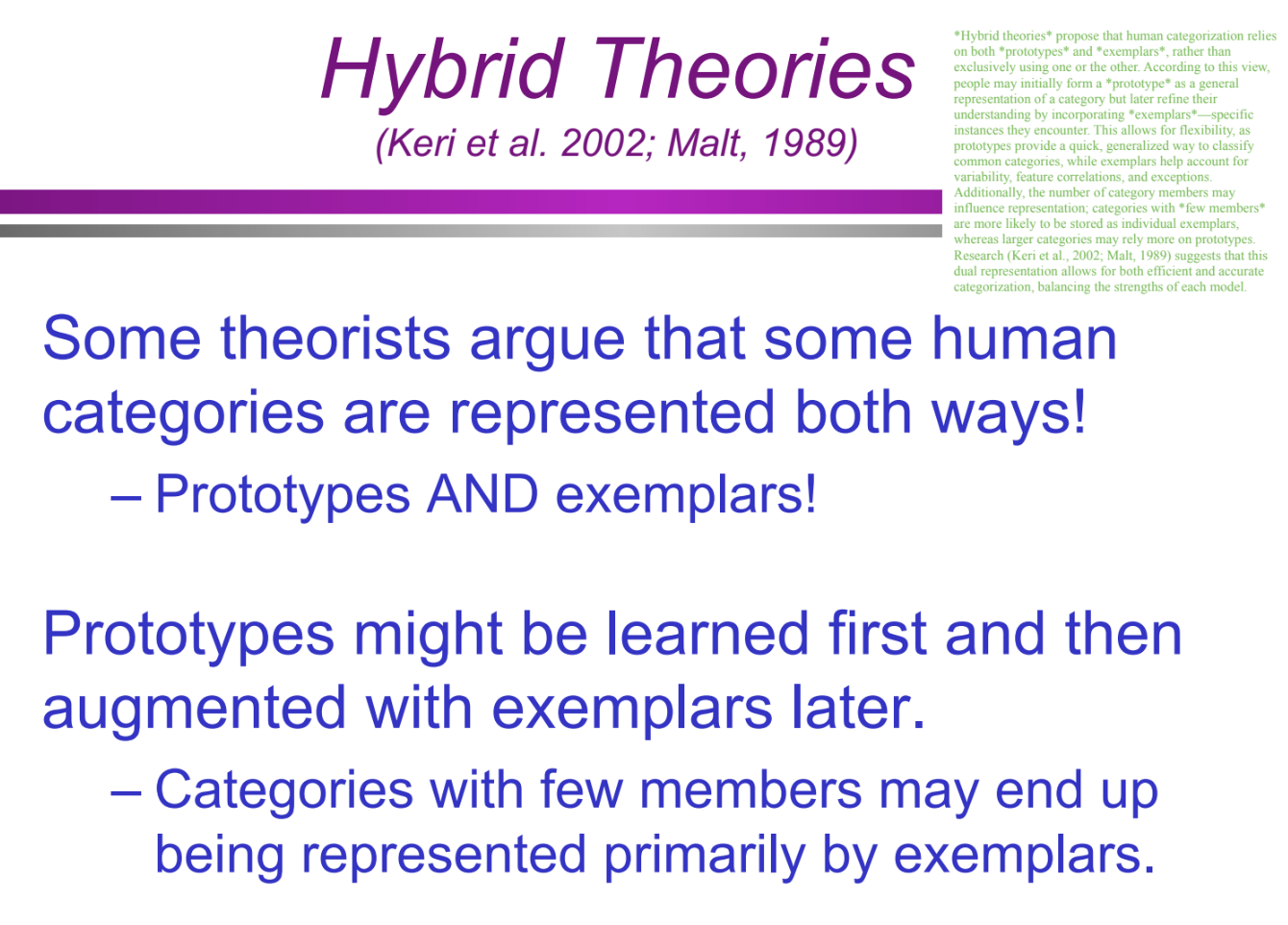
How are different kinds of categories represented? (Categorization/Conceptual Structure)
Object categories (e.g., animals, tools) → Exemplars (based on past experiences).
Social categories (e.g., stereotypes, group identities) → Prototypes (generalized traits).
Defined categories (e.g., math, kinship, legal concepts, sports) → Definitions (clear-cut rules).
This flexibility allows categorization to adapt to different types of information.

What are the key characteristics of the defining theory of categorization? (Categorization/Conceptual Structure: summary)
Mental Representation: Defining features
Method of Classification: Rule application
Method of Learning: Rule discovery
Most Applicable Domain: Categories explicitly defined by people (e.g., legal concepts, mathematical terms, kinship)
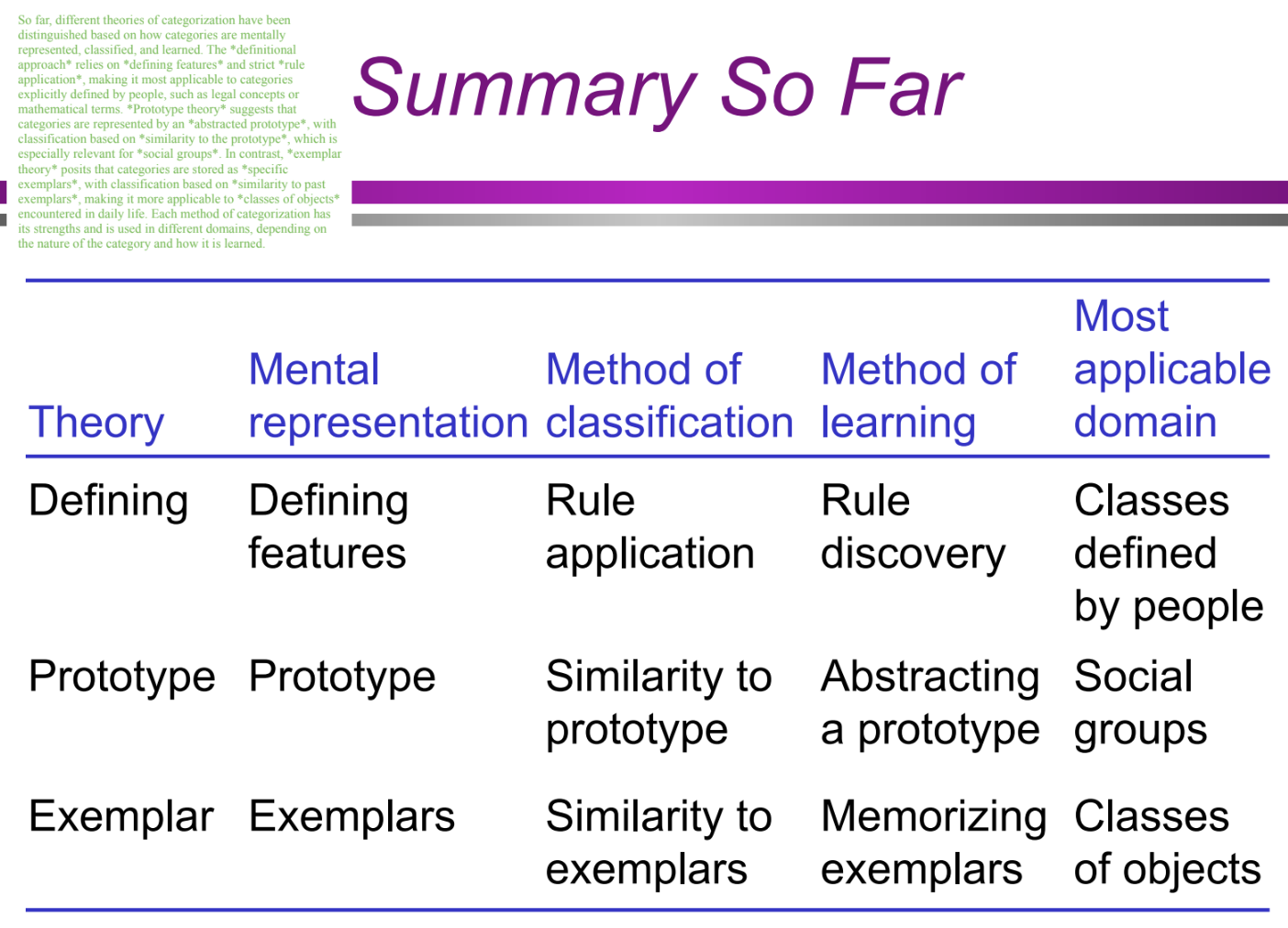
What are the key characteristics of prototype theory? (Categorization/Conceptual Structure: summary)
Mental Representation: Prototype (abstracted category representation)
Method of Classification: Similarity to the prototype
Method of Learning: Abstracting a prototype from multiple examples
Most Applicable Domain: Social groups
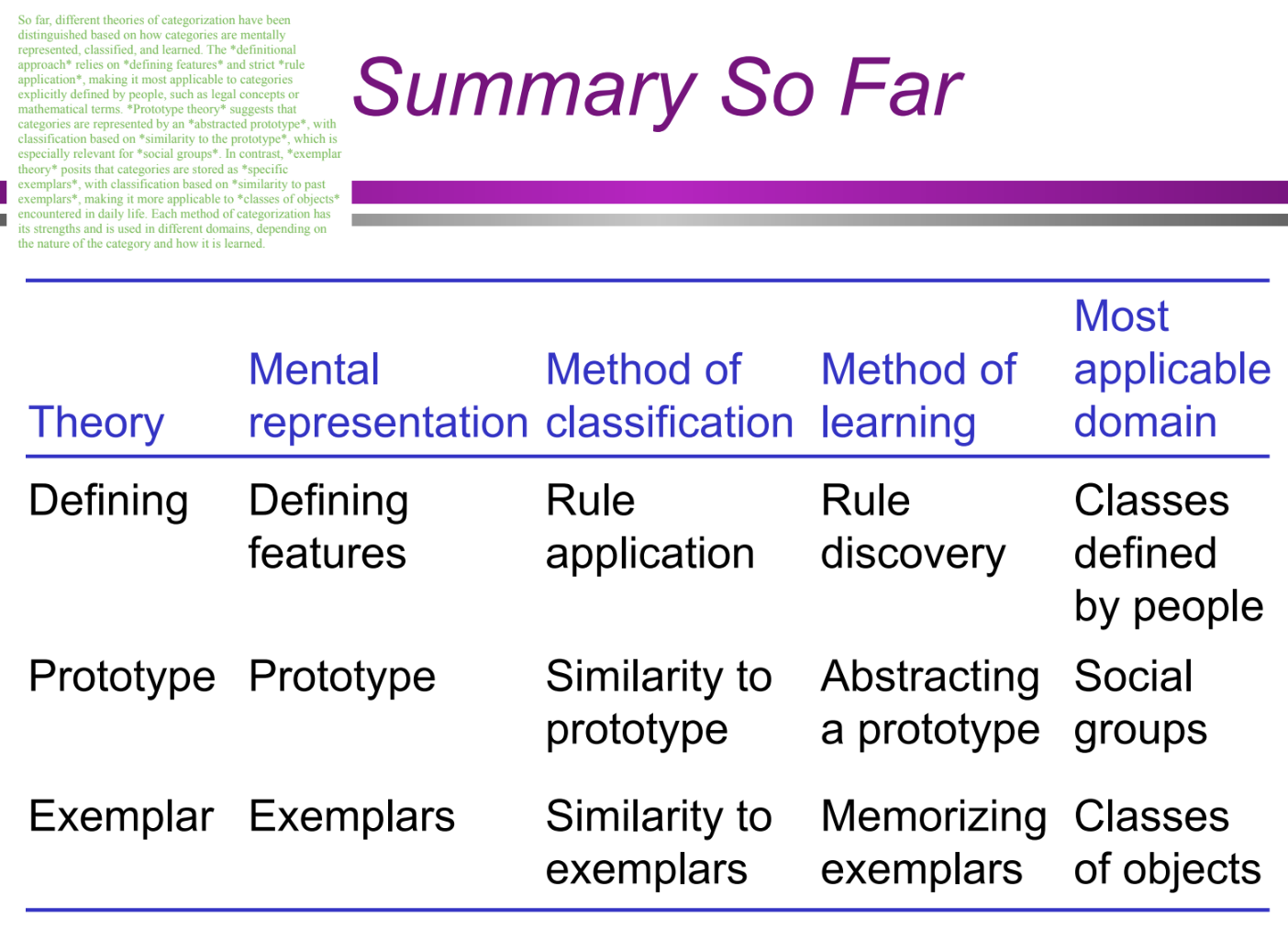
What are the key characteristics of exemplar theory? (Categorization/Conceptual Structure: summary)
Mental Representation: Specific exemplars (stored instances)
Method of Classification: Similarity to exemplars
Method of Learning: Memorizing exemplars from experience
Most Applicable Domain: Classes of objects encountered in daily life
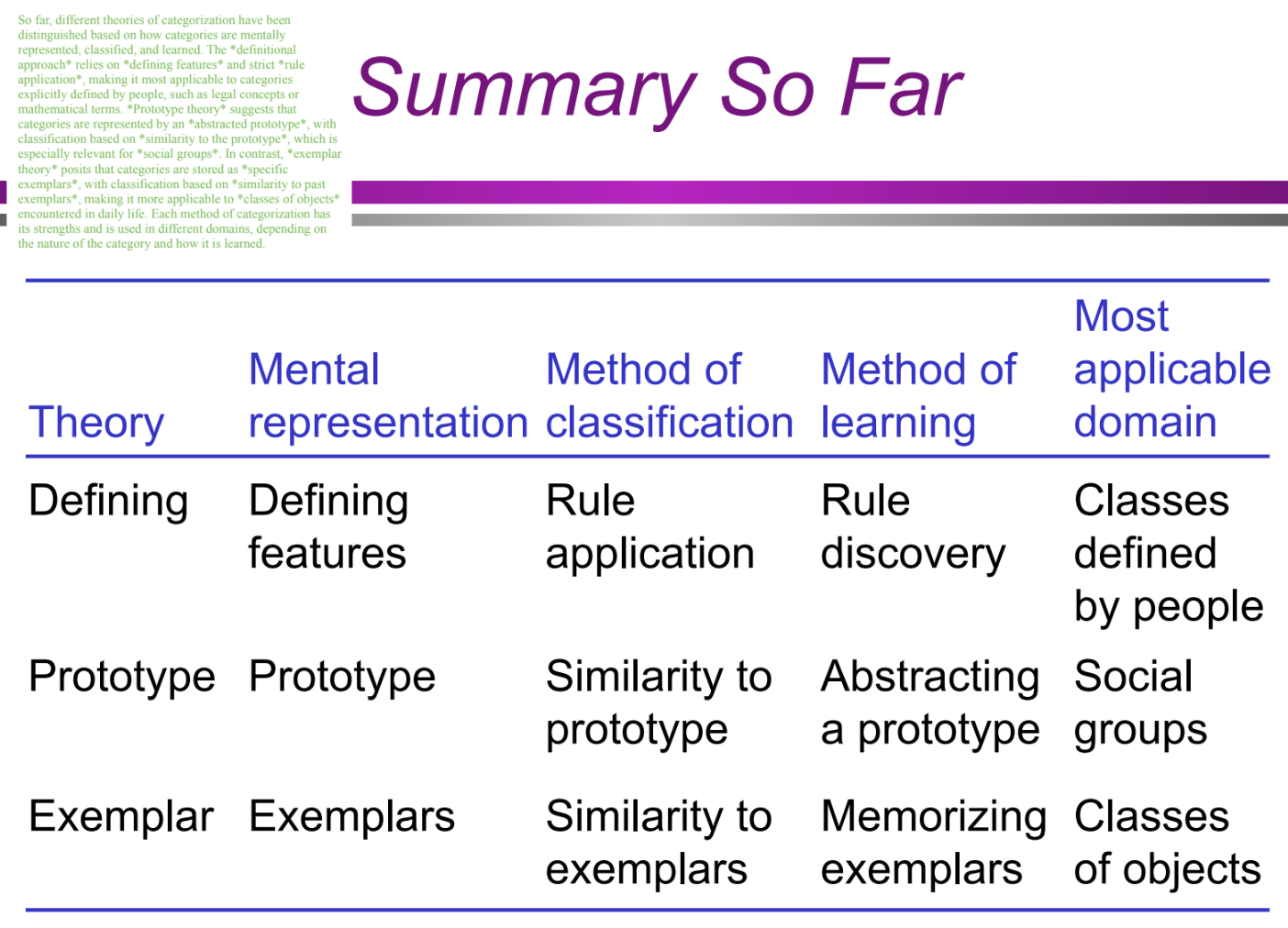
What is Causal Model Theory? (Categorization/Conceptual Structure: causal model views)
Causal Model Theory suggests that categorization is based not just on observable features but on causal relationships between those features.
People understand why category members have certain attributes and how they interact.
This approach helps explain complex systems, learn new concepts, and make predictions about unfamiliar category members.
(Murphy & Medin, 1985; Rehder & Hastie, 2001; Rehder, 2003)
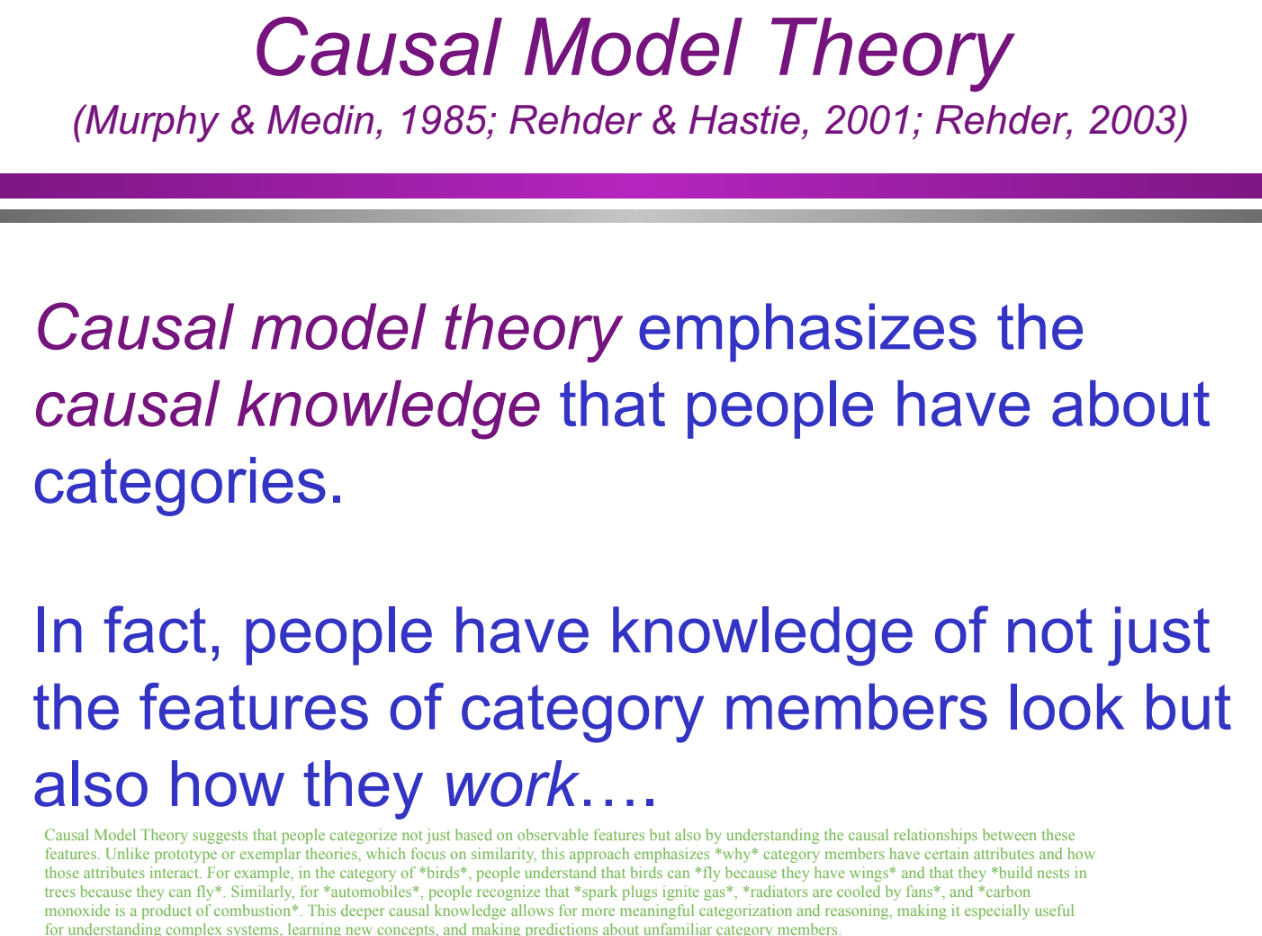
What is causal knowledge in categorization? (Categorization/Conceptual Structure: causal model views)
Causal knowledge refers to understanding how and why category features exist and relate to each other.
It extends beyond just recognizing attributes and includes knowledge about how features function within a system.
Example: Birds fly because they have wings; cars emit carbon monoxide as a result of combustion.
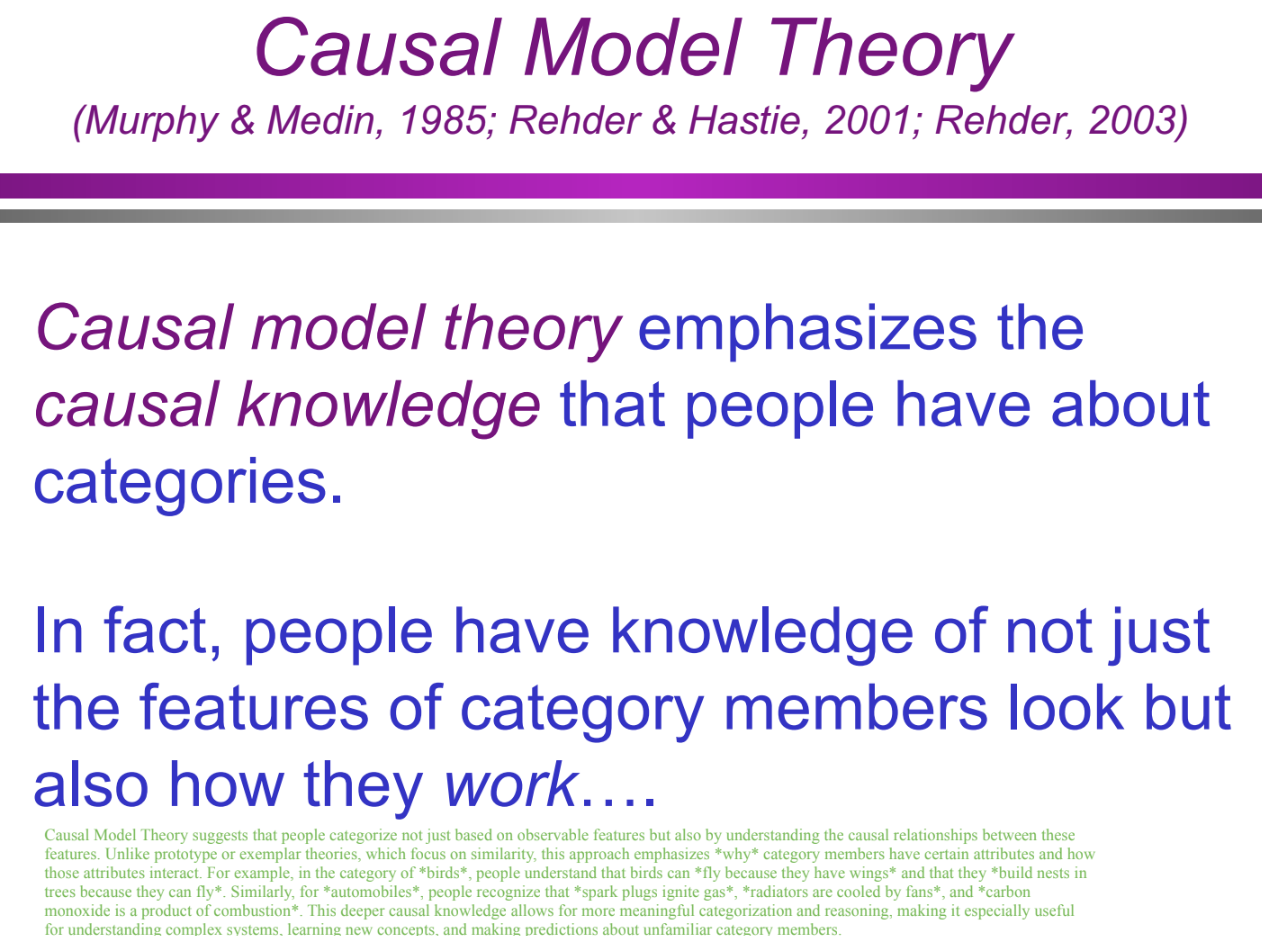
How does causal model theory explain categorization using birds and automobiles? (Categorization/Conceptual Structure: causal model views)
Birds:
Birds fly because they have wings.
Birds build nests in trees because they can fly.
Birds have wings because of their DNA.
Automobiles:
Spark plugs ignite gas, enabling the car to run.
Radiators are cooled by fans because combustion produces heat.
Carbon monoxide is a product of combustion.
Causal model theory highlights how understanding these cause-and-effect relationships helps categorize and reason about category members.

What was the aim of Sloman, Love, & Ahn’s (1998) study? (Categorization/Conceptual Structure: causal model views)
To investigate how people perceive causal relationships between features in everyday categories.
Participants listed features of common objects and mapped how these features depended on one another.
The study aimed to show that categorization is influenced by understanding causal connections rather than viewing features as independent traits.
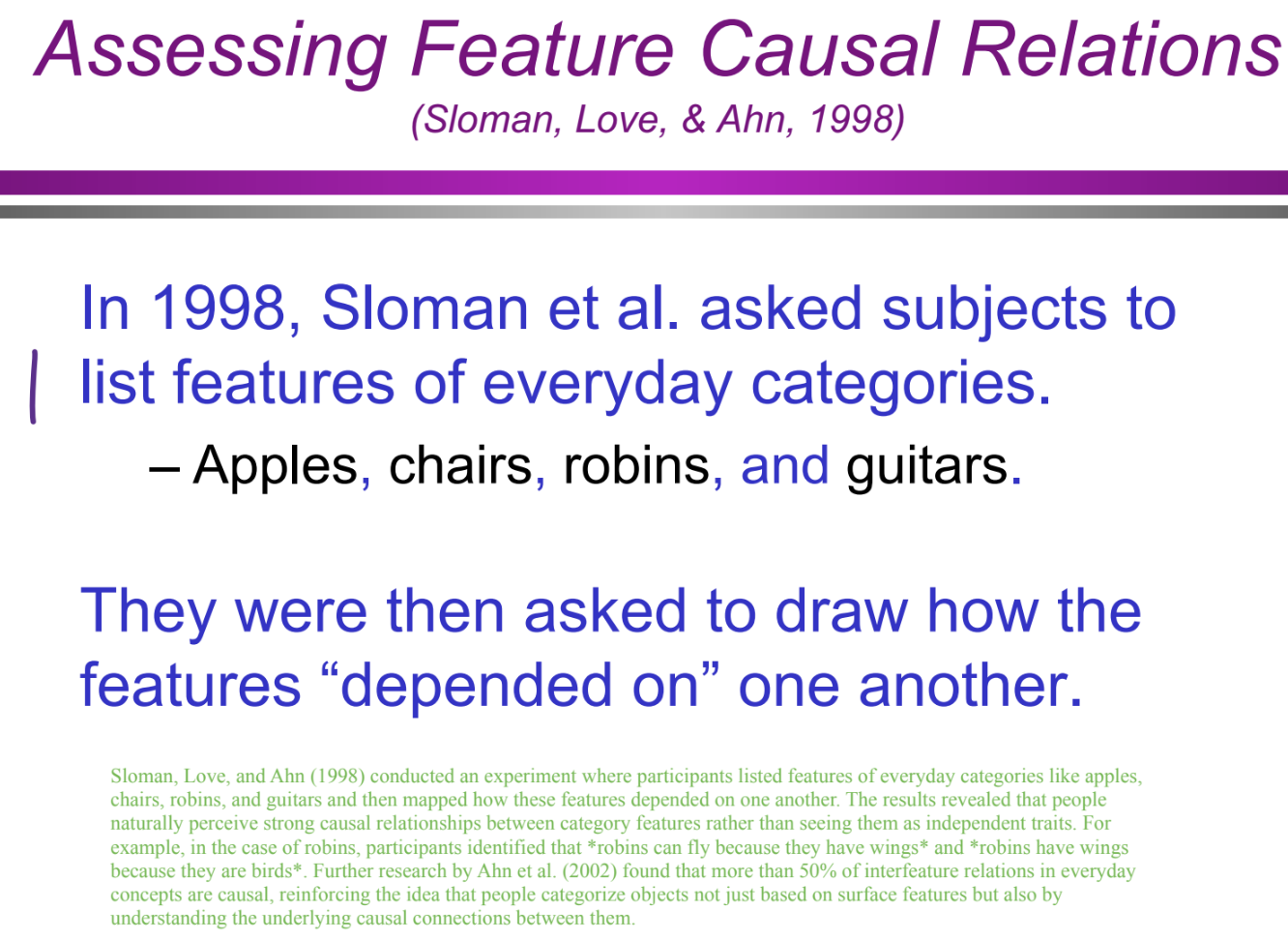
What were the specific steps in Sloman et al.’s procedure? (Categorization/Conceptual Structure: causal model views)
Participants were given everyday categories: apple, chair, robin, guitar.
They listed features of each category.
They were asked to draw how the features “depended on” one another to assess perceived causal relations.
The researchers analyzed the structure of these causal connections.
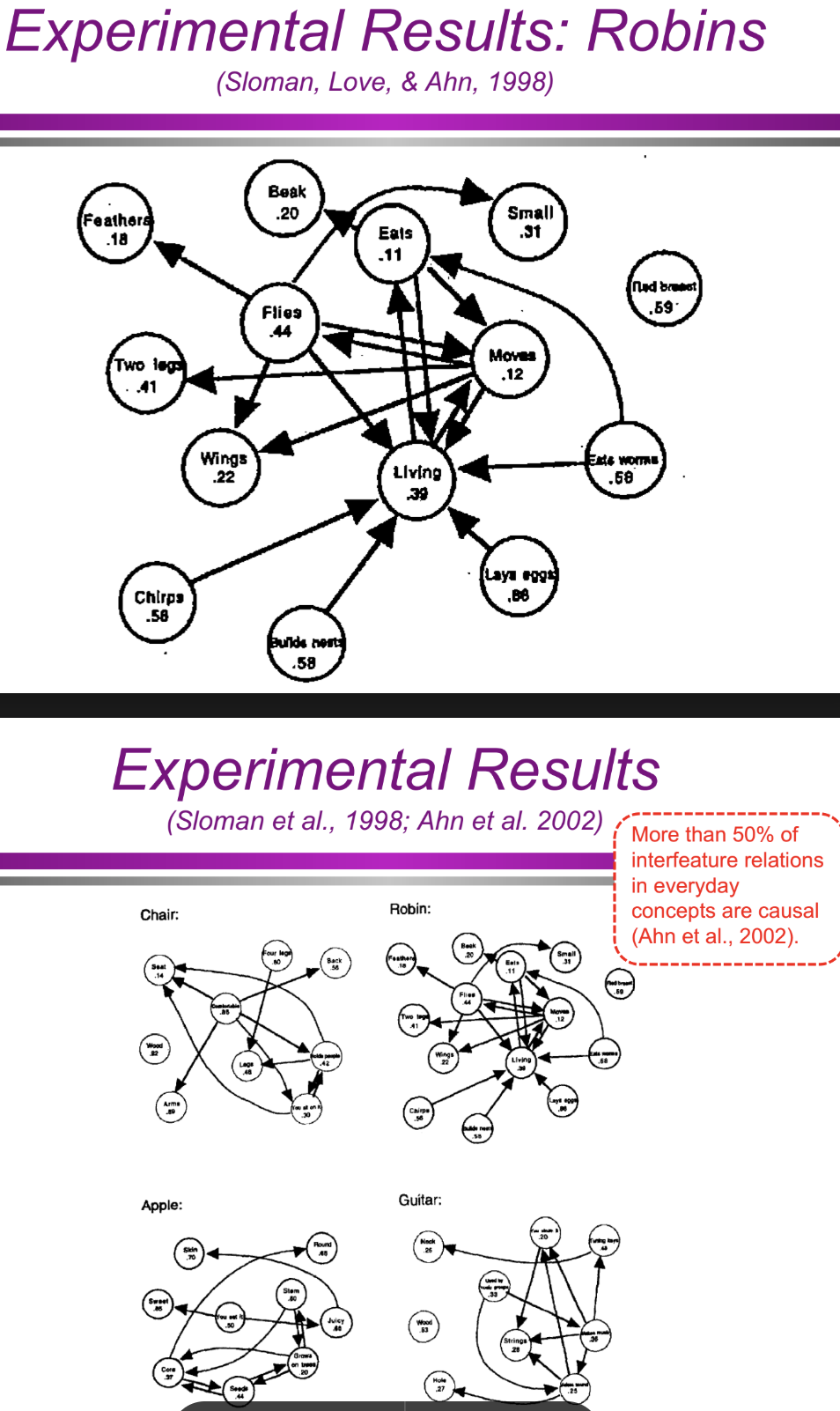
What were the key results of Sloman et al.’s study? (Categorization/Conceptual Structure: causal model views)
Participants identified strong causal relationships between category features.
Example (Robin):
Robins can fly because they have wings.
Robins have wings because they are birds.
More than 50% of interfeature relations in everyday concepts are causal (Ahn et al., 2002).
Findings suggest people categorize based on causal knowledge, not just shared attributes.
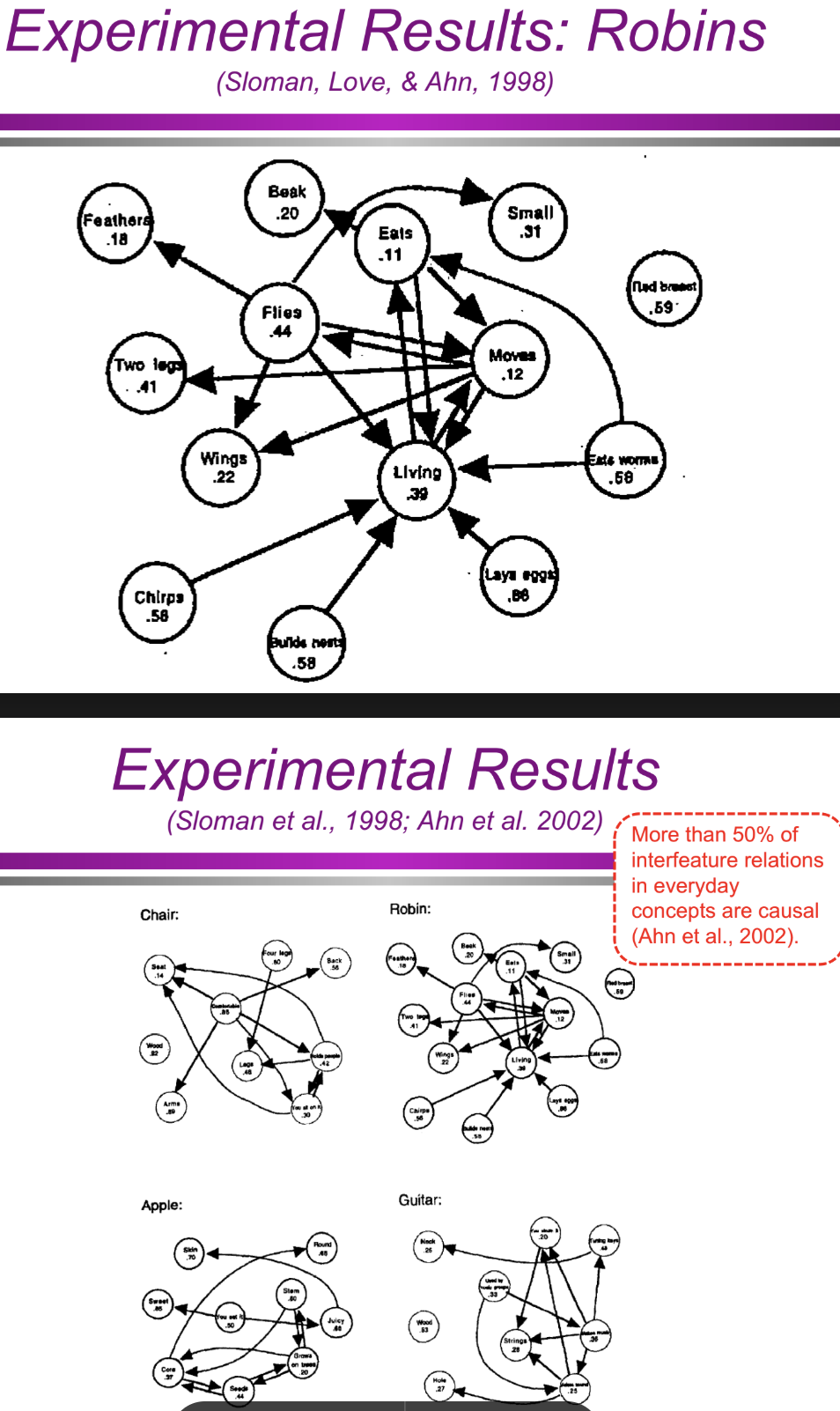
According to Causal Model Theory, what do categories consist of?(Categorization/Conceptual Structure: causal model views)
Categories consist of features and causal relations that are organized into a causal model.
A causal model is like a prototype, but it is augmented with causal knowledge that explains how features relate to one another.
People categorize objects not just by shared features but also by understanding the causal connections between those features.
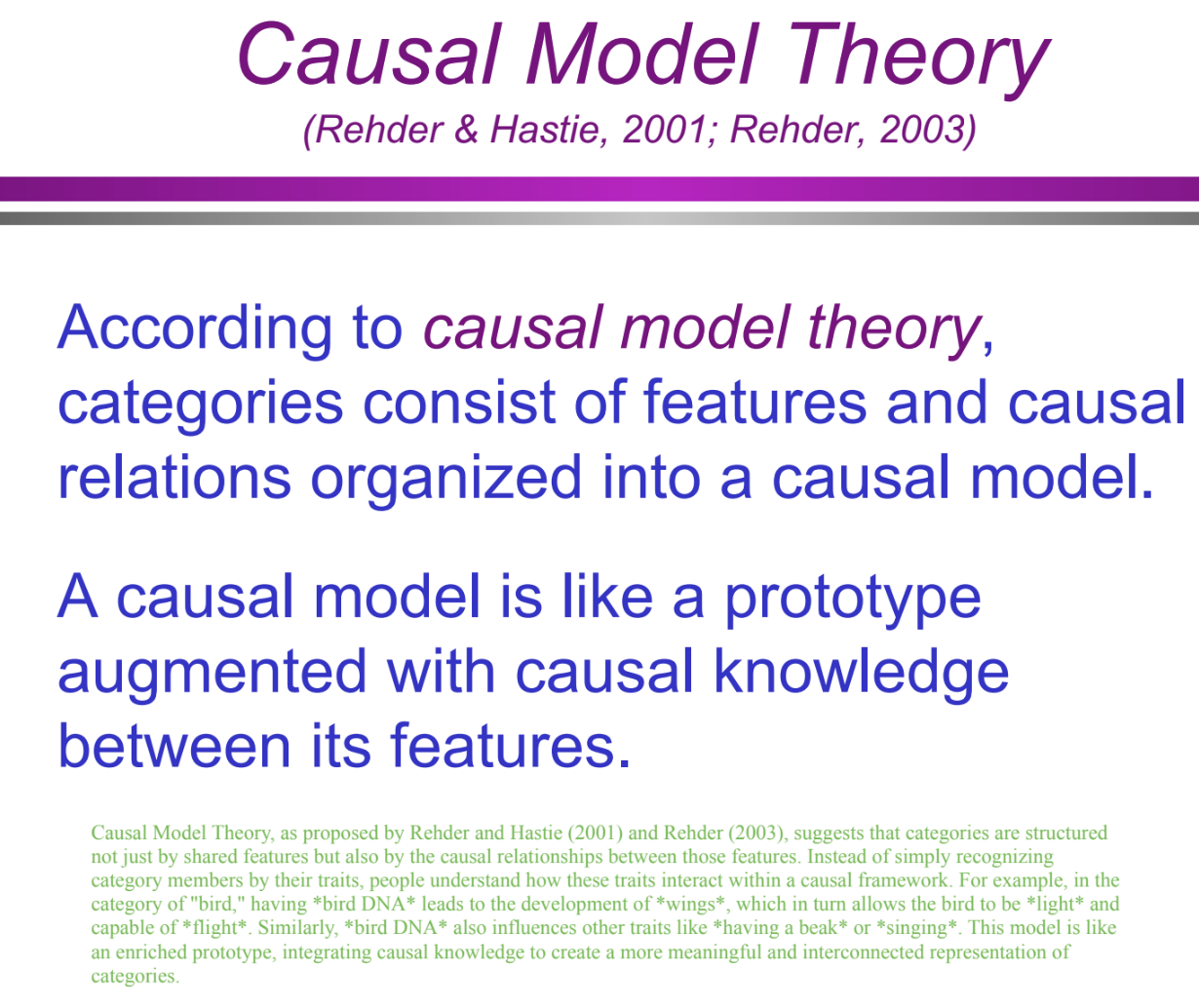
How does Causal Model Theory explain categories like birds and automobiles? (Categorization/Conceptual Structure: causal model views)
Birds:
Bird DNA → Wings → Flight
Wings → Lightness → Flight capability
Bird DNA → Beak → Singing
Automobiles:
Gasoline → Spark plugs → Engine power
Radiator → Fan → Reduced heat
Tailpipe → Carbon monoxide → Pollution
These categories are structured by how features depend on each other causally, creating a causal model that explains how each feature functions in relation to the others.
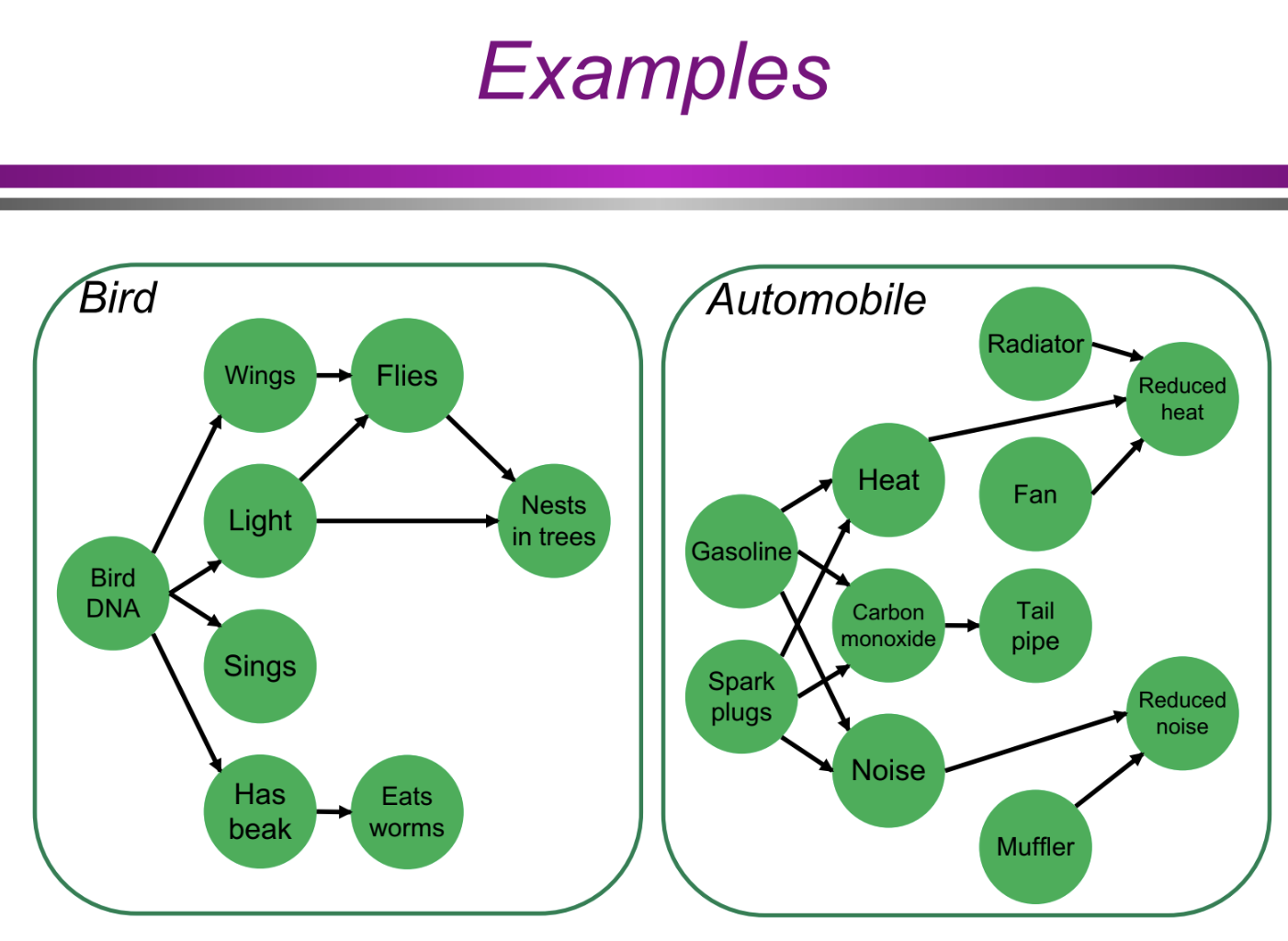
What was the general aim of Rehder and Kim's (2010) study? (Categorization/Conceptual Structure: causal model views)
The study aimed to investigate how causal knowledge influences categorization decisions.
Specifically, they wanted to determine whether people rely on causal relationships between features when classifying novel items.
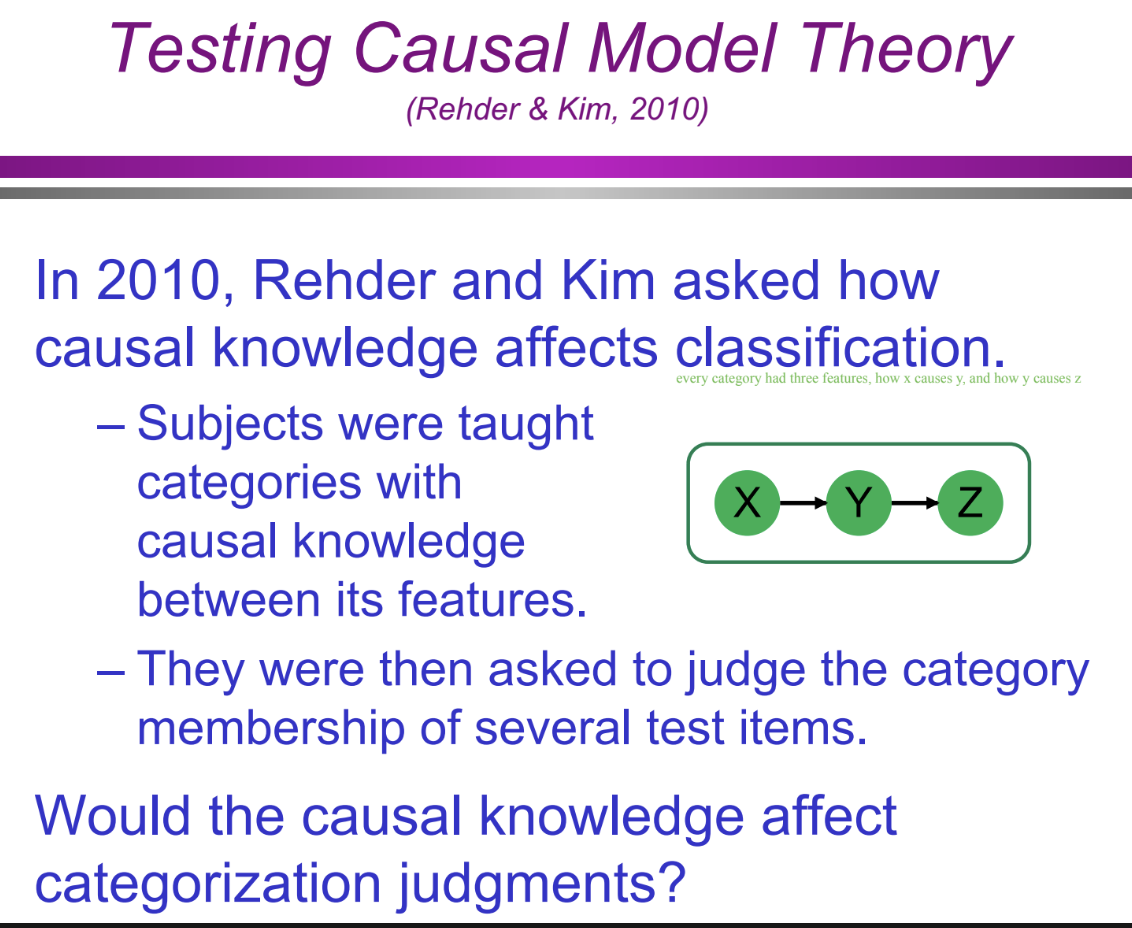
What were the specific steps of the procedure in Rehder and Kim's (2010) study? (Categorization/Conceptual Structure: causal model views)
Introduction to categories: Participants were taught about a novel category (e.g., Kehoe Ants) defined by three features (e.g., hyperactive immune system, thick blood, fast nest building).
Causal condition vs. control condition:
Causal condition: Participants were provided with causal relations linking the features (e.g., a hyperactive immune system causes thick blood).
Control condition: No causal information was given.
Classification test: Participants rated the membership of eight test items formed by different combinations of these features, judging whether they belonged to the category.
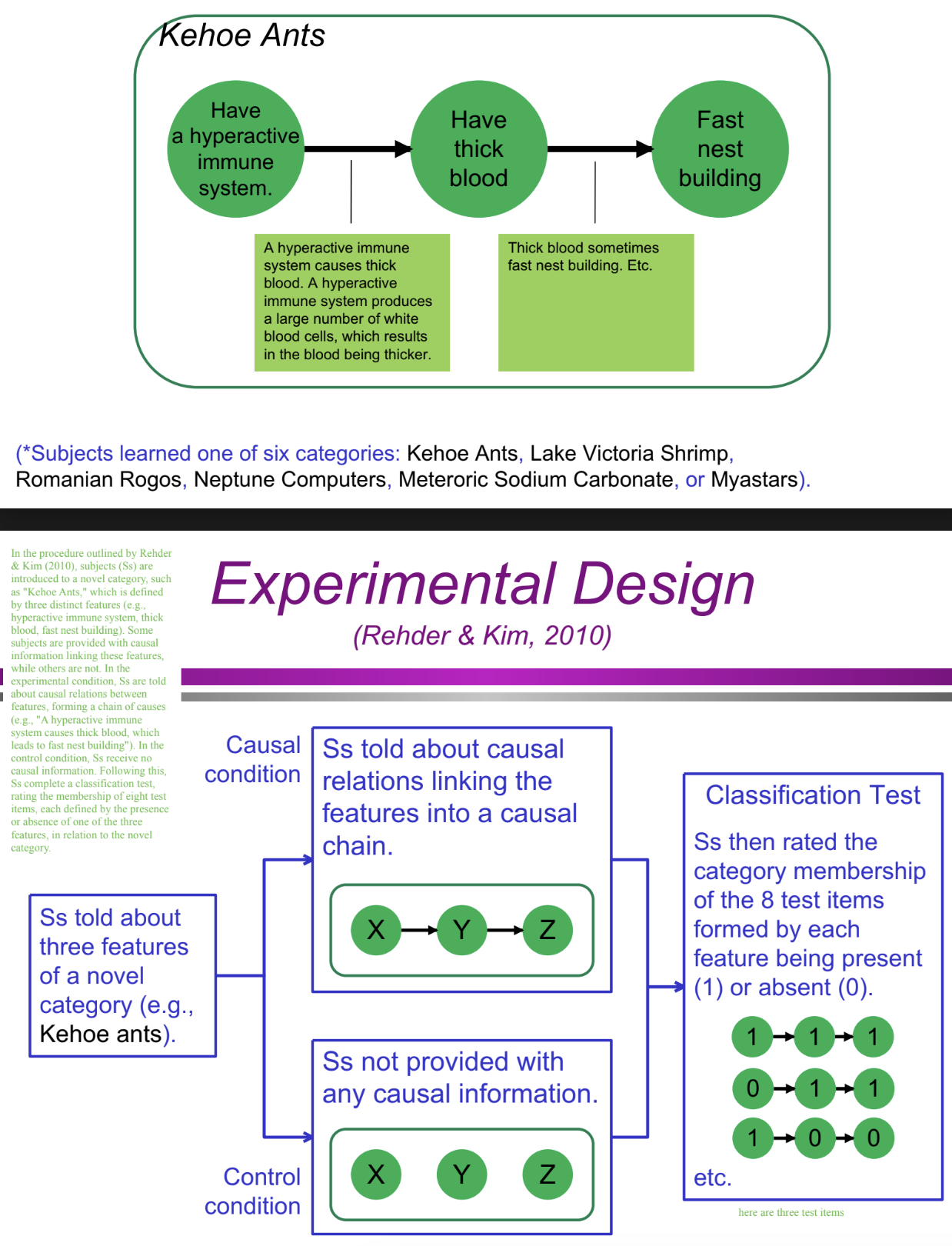
How was the data analyzed in Rehder and Kim's (2010) study? (Categorization/Conceptual Structure: causal model views)
Test items were aggregated based on two factors:
Number of features: How many features the test item shared with the category.
Causal violations: Whether a cause was present but its expected effect was missing (e.g., cause present/effect absent).
Causal violations were counted as violations, and participants' categorizations were analyzed based on these two variables.
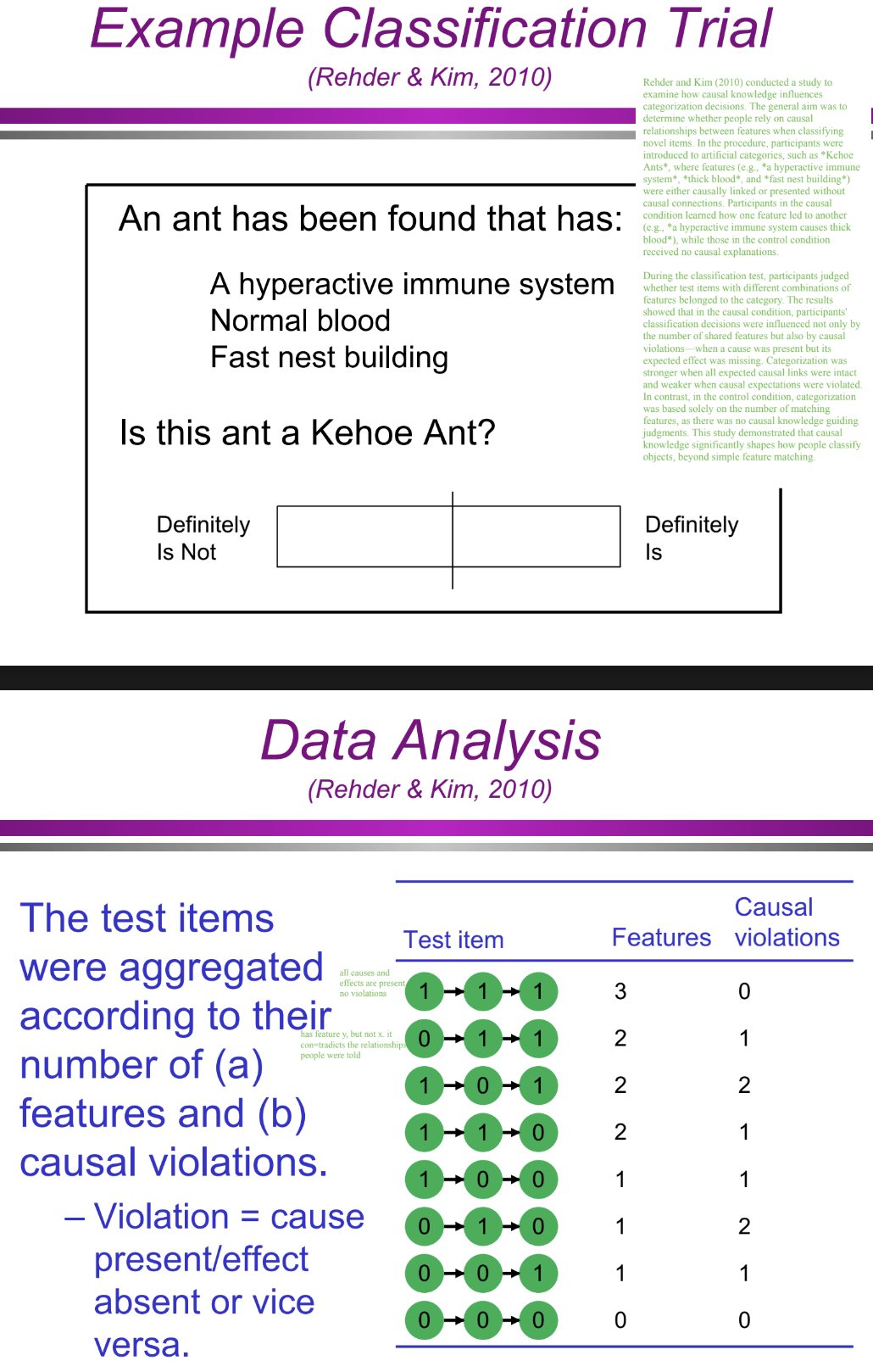
What were the specific results of Rehder and Kim's (2010) study in both the causal and control conditions? (Categorization/Conceptual Structure: causal model views)
Causal Condition:
Categorization increased with the number of features.
Causal violations led to a decrease in categorization ratings. As the number of violations increased, categorization ratings decreased, showing the coherence effect (how well features align with each other causally).
Control Condition:
Categorization increased with the number of features.
There was no effect of causal violations, as no causal knowledge guided participants' judgments. Thus, violations did not matter.
This demonstrated that causal knowledge affects categorization by making it more sensitive to the coherence of features within a category.
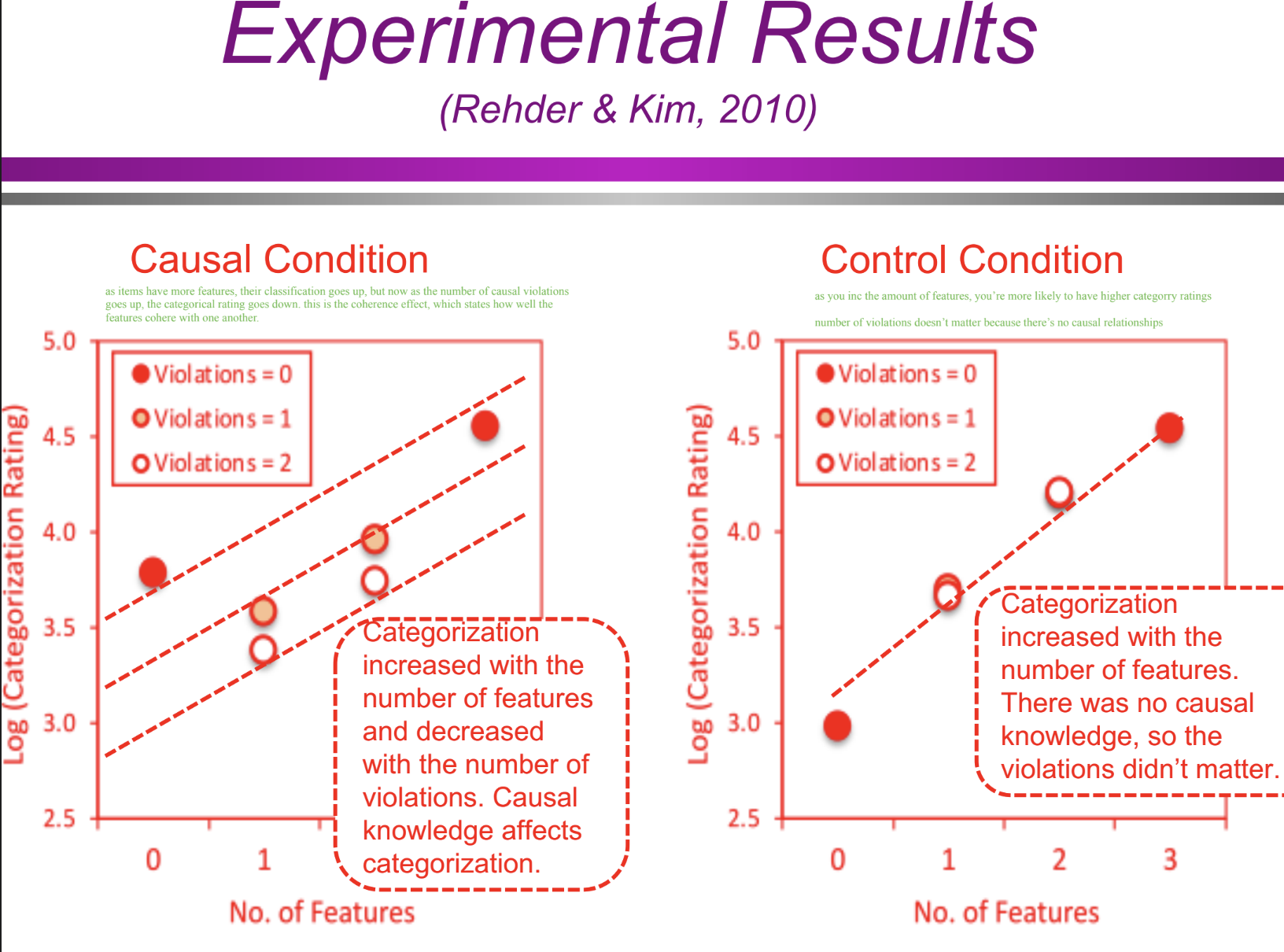
What was the general aim of Kim and Ahn's (2002) study? (Categorization/Conceptual Structure: causal model views)
The study aimed to assess clinicians' causal models of mental disorders and determine whether these models influence their diagnostic decisions.
They investigated whether clinicians rely solely on DSM features (which follow prototype theory) or incorporate causal theories in their diagnoses.
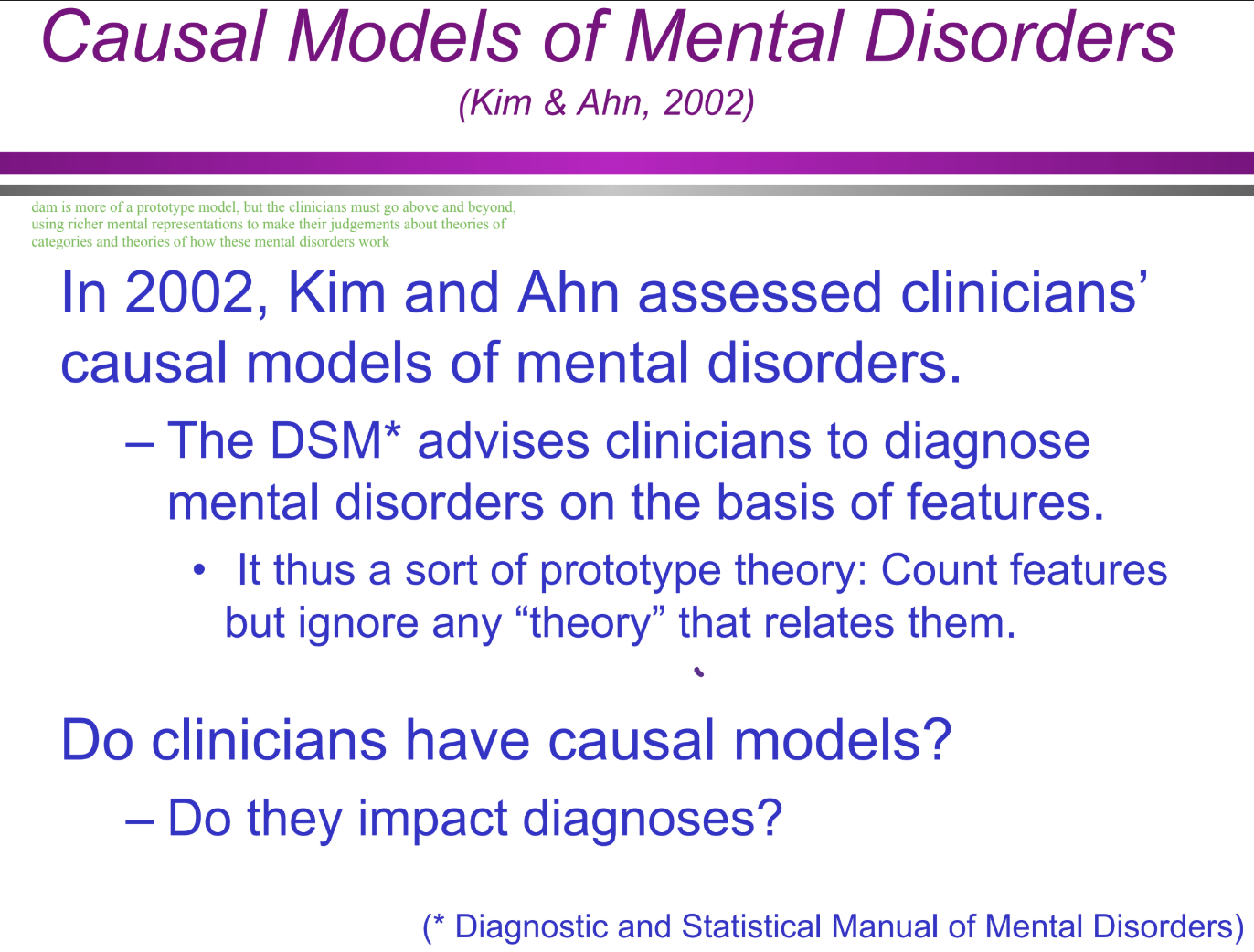
What was the specific procedure of Kim and Ahn's (2002) study? (Categorization/Conceptual Structure: causal model views)
Presentation of case descriptions: Clinicians were given descriptions of various mental disorders, such as anorexia nervosa, anti-social personality disorder, and depression.
Feature list: Along with the descriptions, clinicians were shown features potentially matching each disorder.
Causal relationships: Clinicians were asked to figure out how the features were related causally.
Diagnosis: They were then tasked with making diagnoses based on both the features and their understanding of the causal relationships between them.
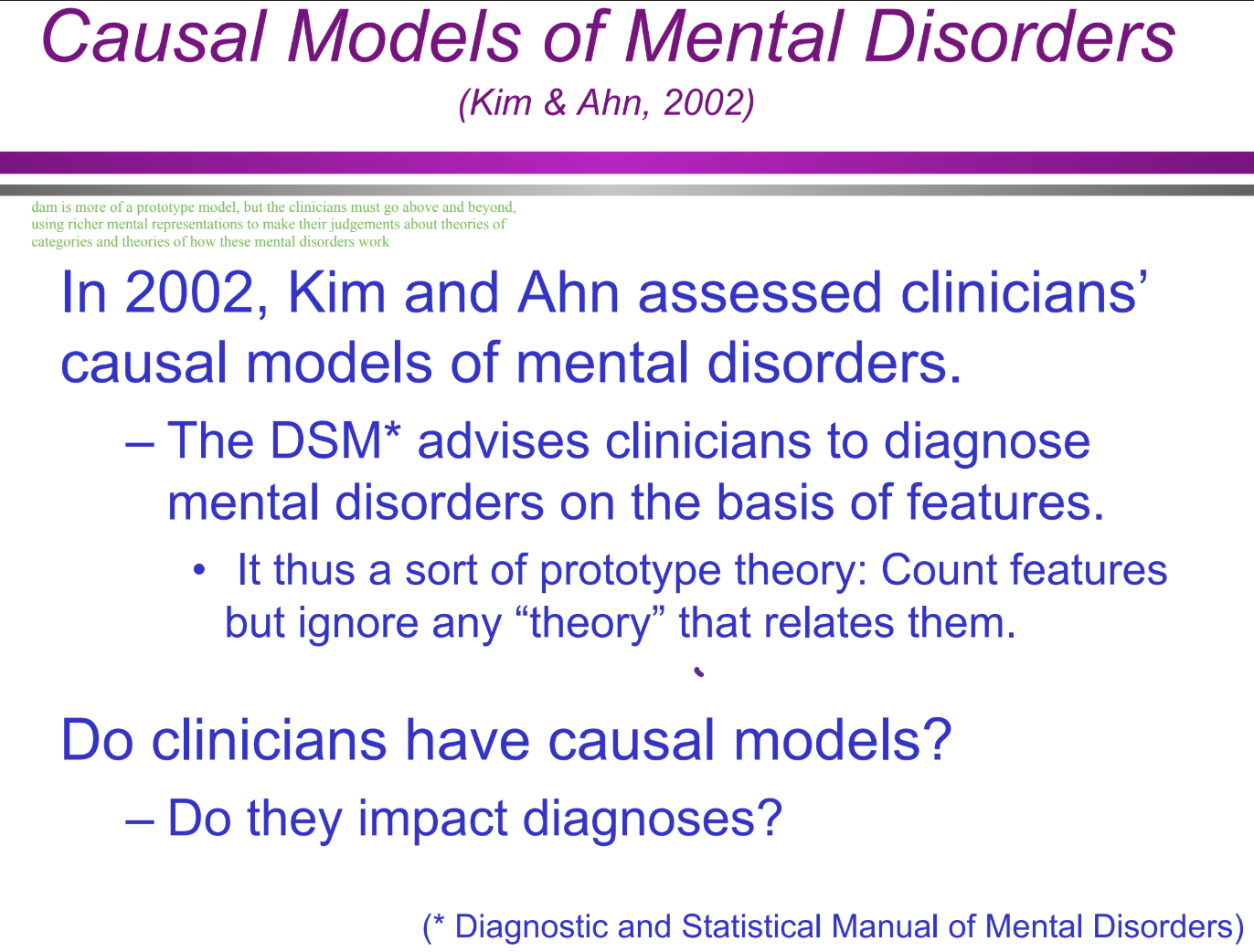
What were the results of Kim and Ahn's (2002) study? (Categorization/Conceptual Structure: causal model views)
Clinicians possessed rich causal models of mental disorders.
These causal models significantly influenced their diagnostic decisions, beyond just considering the features listed in the DSM.
Clinicians used their understanding of causes to shape their diagnoses, suggesting that their judgments were not based purely on counting symptoms.

What is a causal model of anorexia nervosa according to Kim & Ahn (2002)? (Categorization/Conceptual Structure: causal model views)
Causal factors:
Body dissatisfaction → Dieting behaviors → Extreme weight loss
Negative reinforcement (avoiding feelings of distress) → Continued dieting
Social pressures → Internalization of beauty ideals → Body image distortion
Genetic factors → Increased vulnerability to the disorder
Mental health history → Comorbid conditions (e.g., depression)
The interaction of these causal factors leads to the development and maintenance of anorexia nervosa.
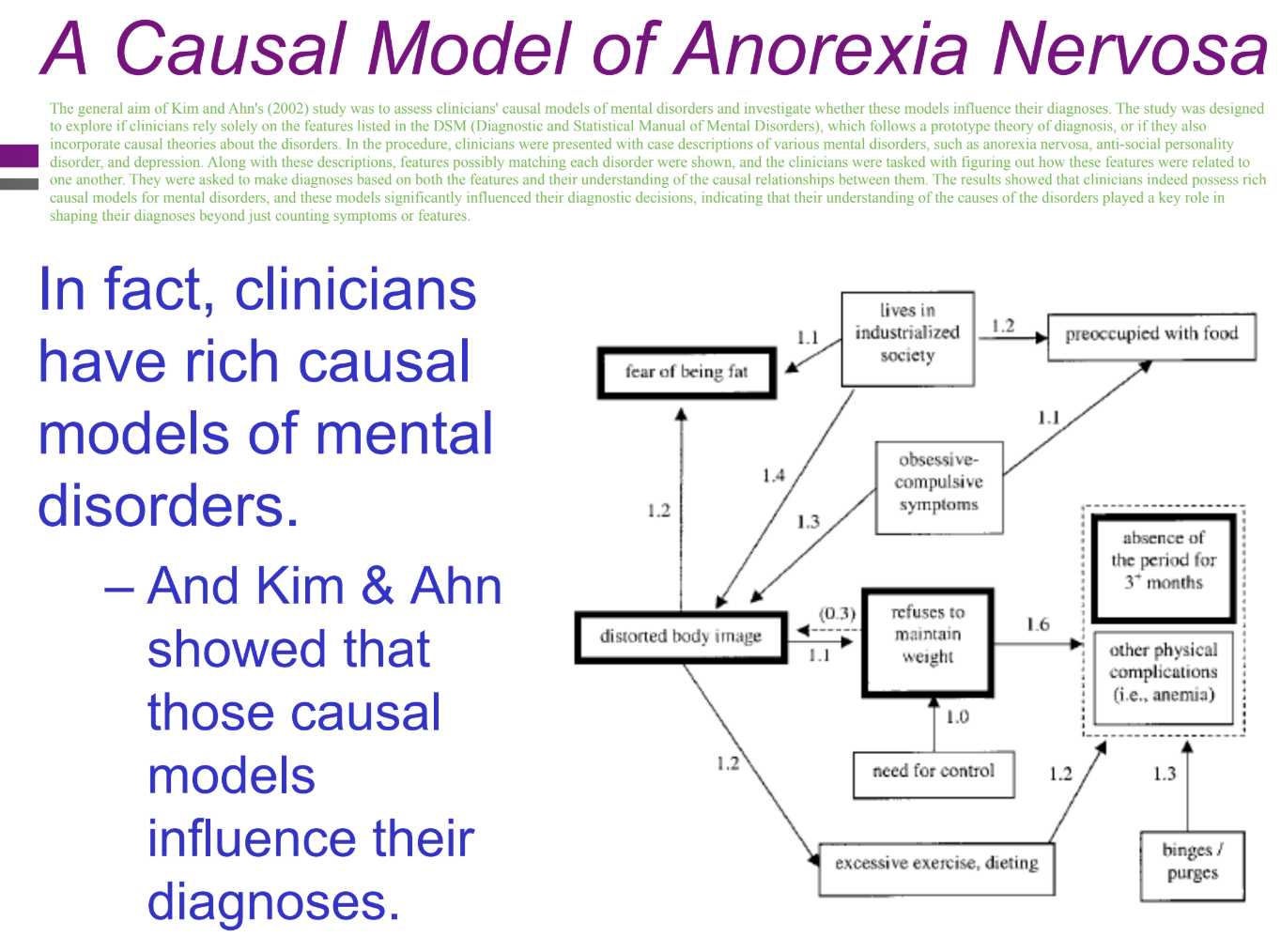
What is a causal model of anti-social personality disorder (ASPD)? (Categorization/Conceptual Structure: causal model views)
Causal factors:
Early childhood trauma (e.g., neglect, abuse) → Deficient empathy
Genetic predisposition → Impulsivity and aggression
Lack of social bonds → Difficulty forming healthy relationships
Reinforced antisocial behaviors (e.g., through positive reinforcement in social environments) → Criminal behavior
Low stress tolerance → Failure to conform to social norms
These factors contribute to the persistent violation of others' rights and the inability to feel guilt in ASPD.
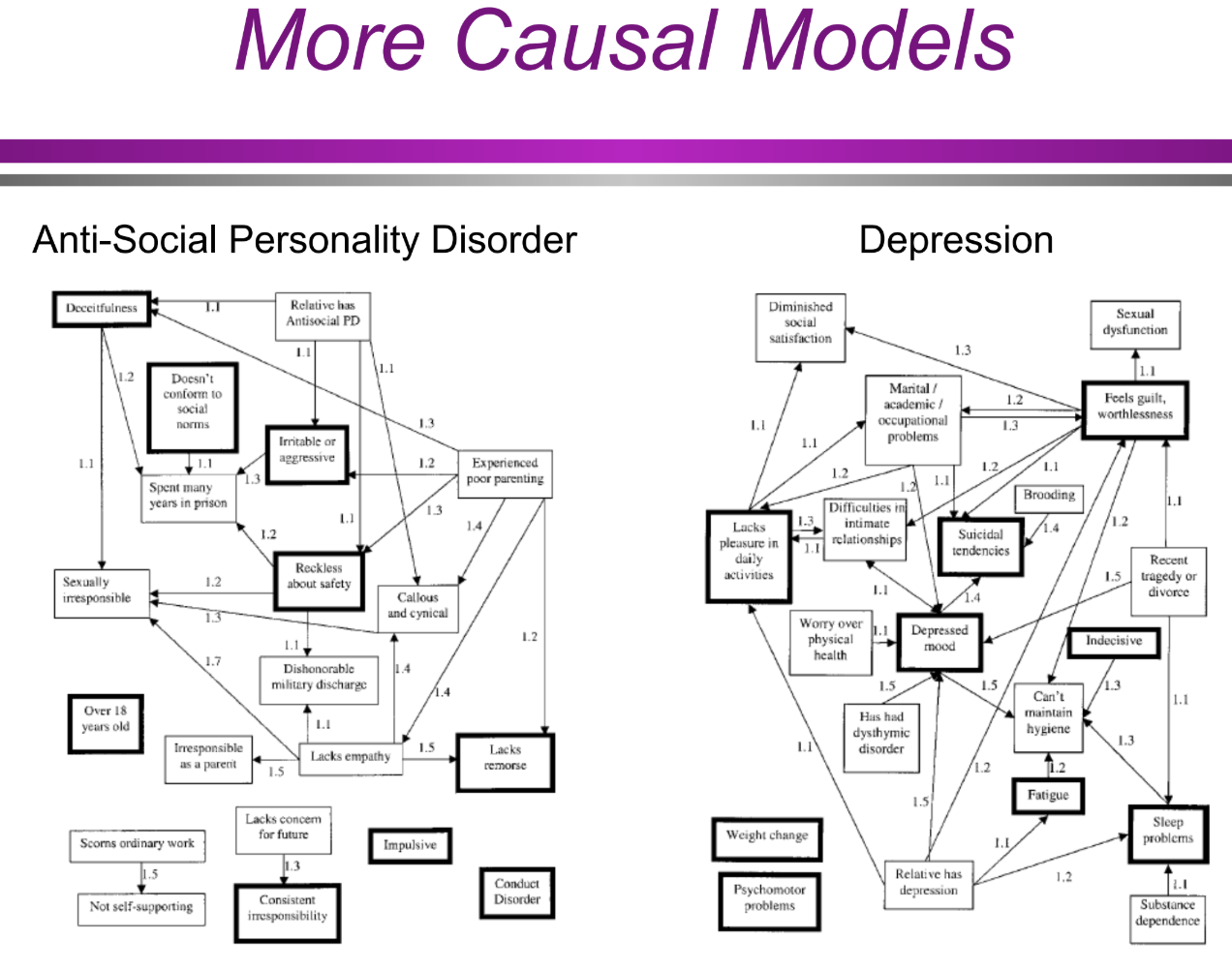
What is a causal model of depression? (Categorization/Conceptual Structure: causal model views)
Causal factors:
Biological factors (e.g., neurotransmitter imbalances, genetic predisposition) → Increased vulnerability to depression
Negative life events (e.g., loss, trauma) → Heightened stress → Depressive symptoms
Cognitive distortions (e.g., negative self-views, hopelessness) → Perpetuation of depressive thoughts
Social isolation → Lack of emotional support → Worsening of symptoms
Chronic health issues → Exacerbation of depression
These factors contribute to persistent sadness, low energy, and disinterest in life, typical of depression.

What does causal model theory show? (Categorization/Conceptual Structure: causal model views: summary)
Causal model theory demonstrates that classification is not solely based on feature-based similarity, unlike prototype or exemplar theory.
In fact, some categories may share no features at all, yet people can still categorize them accurately by understanding the causal relationships between features.

What do the examples of "things to take on a camping trip," "things to eat while on a diet," and "things to take out of the house in case of fire" show? (Categorization/Conceptual Structure: causal model views: goal derived)
These examples illustrate goal-derived (or ad hoc) categories, where items are grouped together based on a shared purpose or goal rather than common features.
The members of these categories do not share physical characteristics, but are linked by their utility in achieving a specific goal.
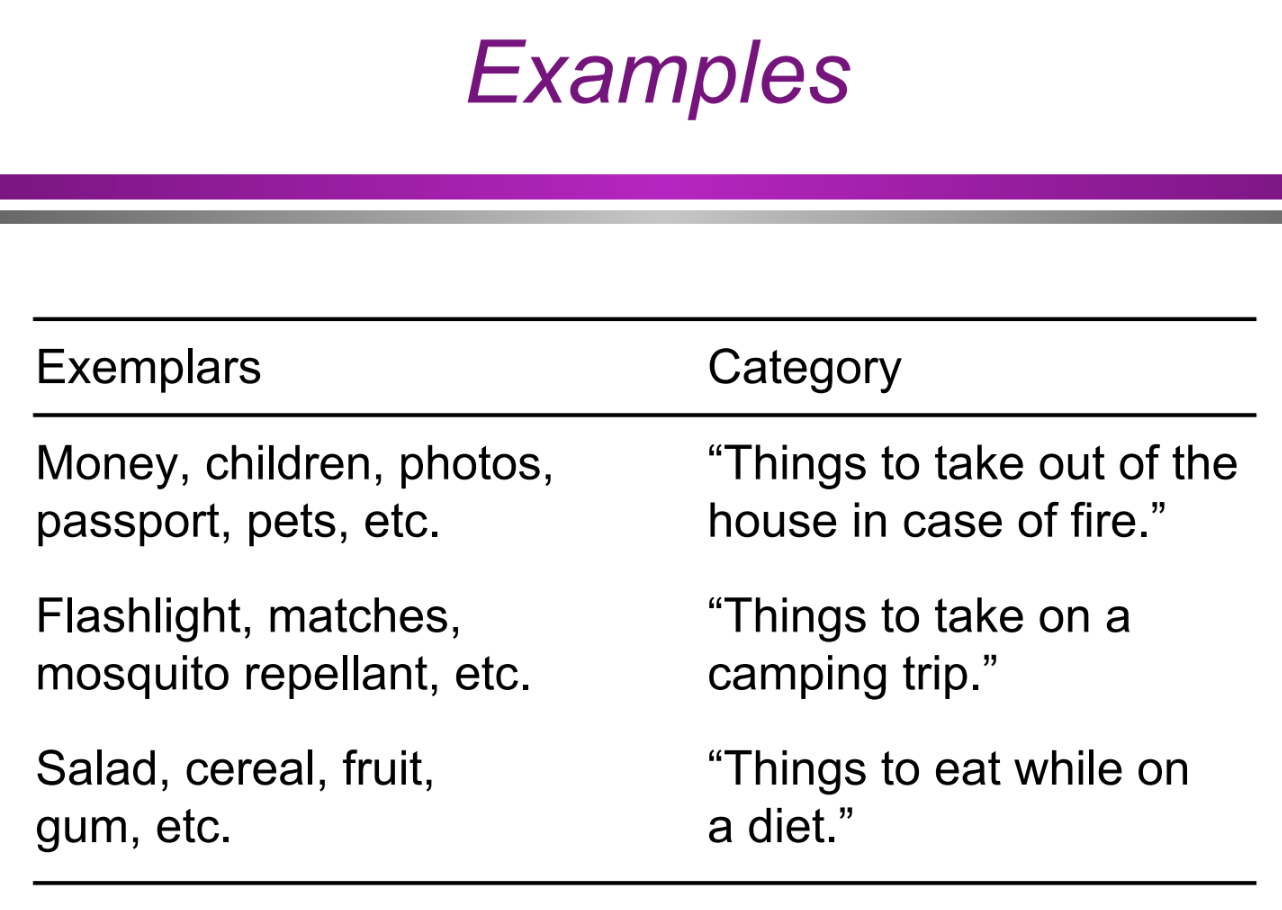
What are goal-derived or ad hoc categories? (Categorization/Conceptual Structure: causal model views: goal derived)
Goal-derived or ad hoc categories are spontaneous groupings formed to satisfy a specific goal or purpose.
The members of these categories are not defined by shared features but are grouped together because they are useful for achieving a particular objective.
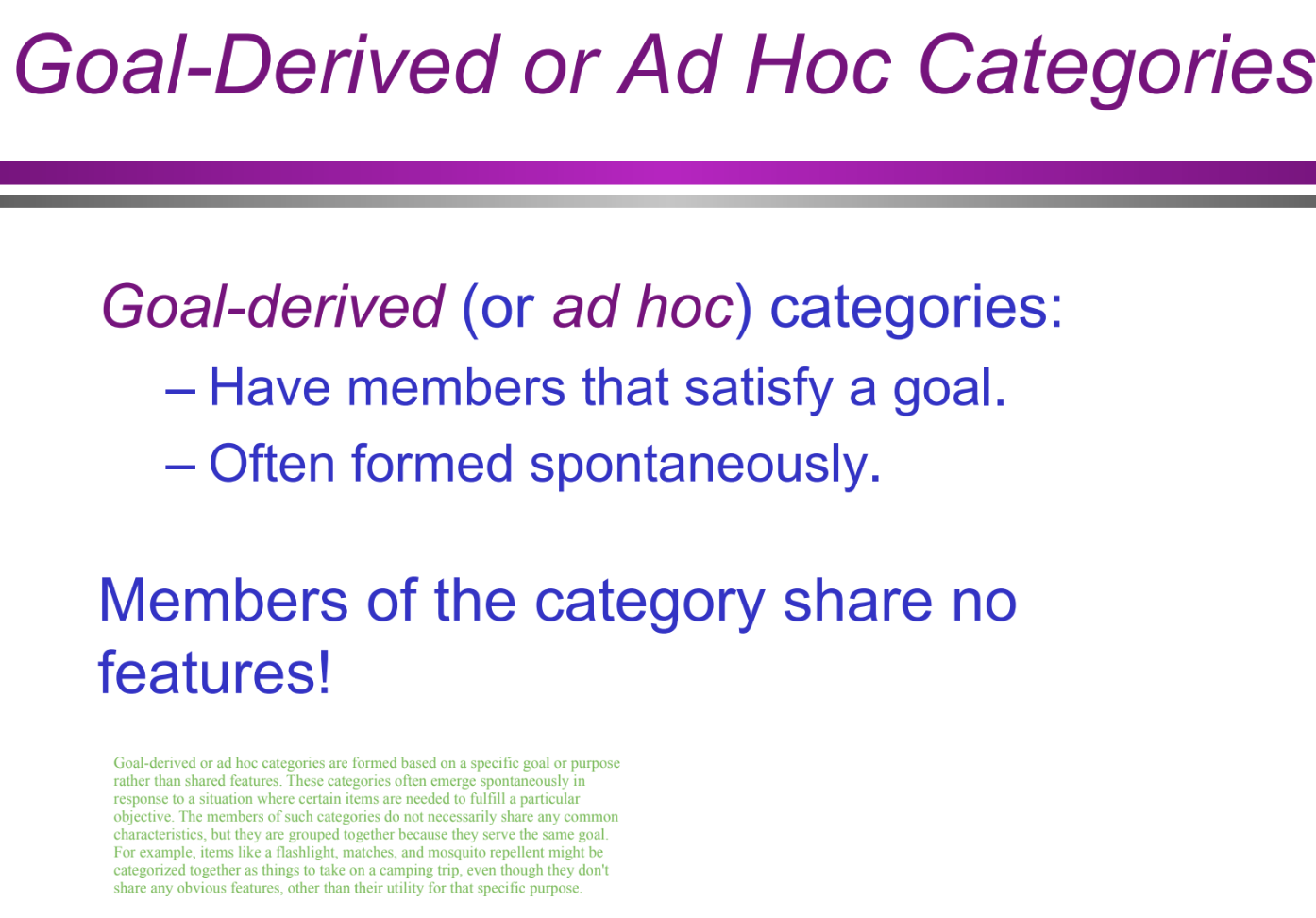
Do members of the category share features in goal-derived or ad hoc categories? (Categorization/Conceptual Structure: causal model views: goal derived)
No, members of goal-derived or ad hoc categories do not share features.
These categories are based on the function or purpose the items serve in a specific context (e.g., items needed for a camping trip or to take in case of a fire).
